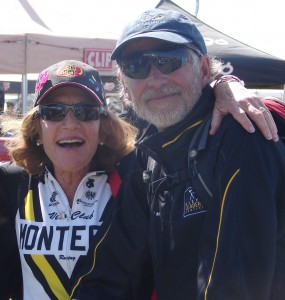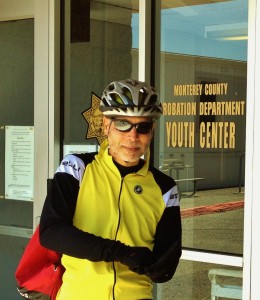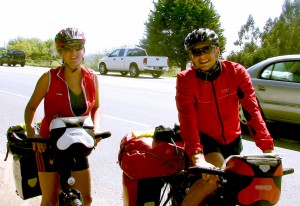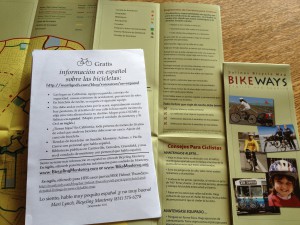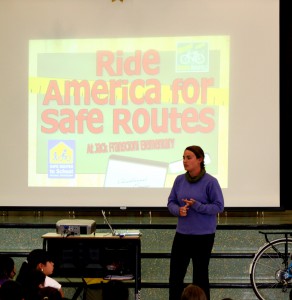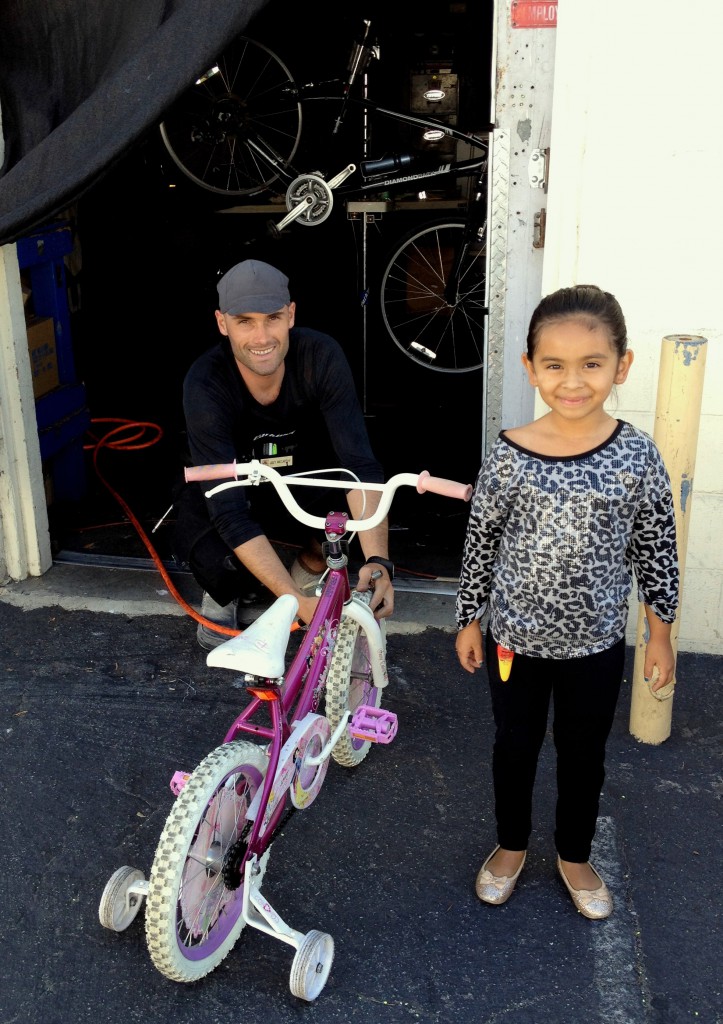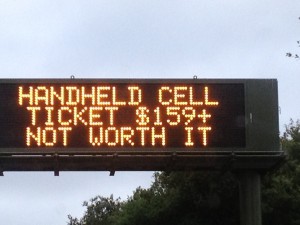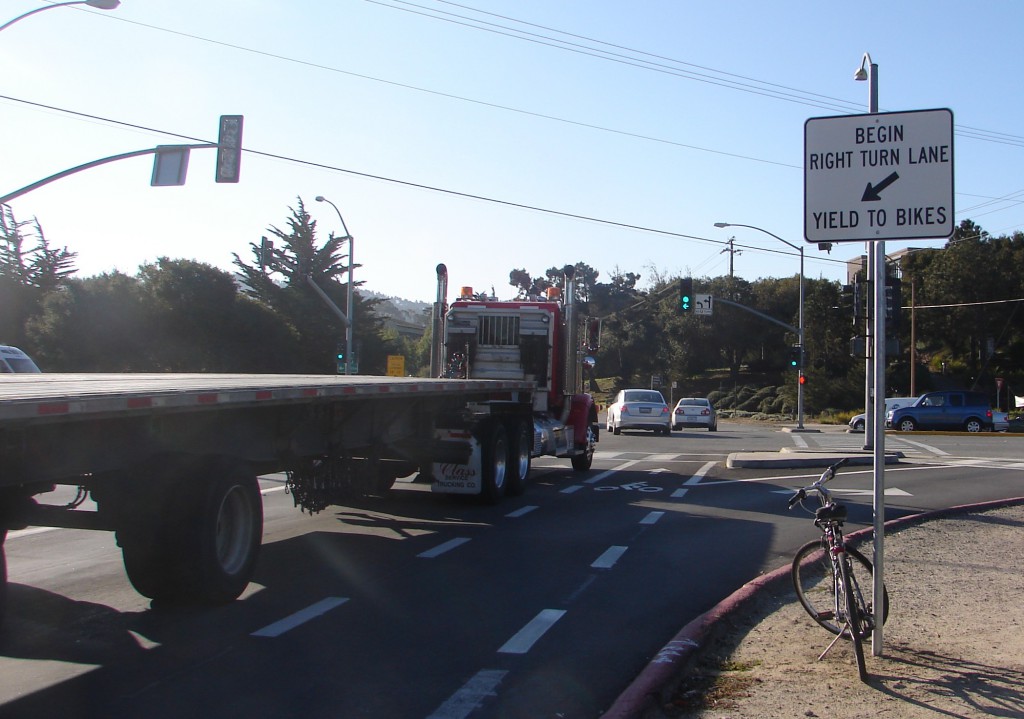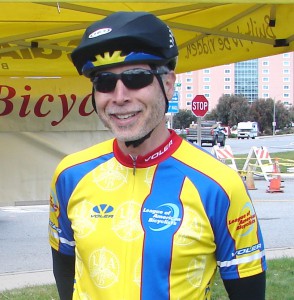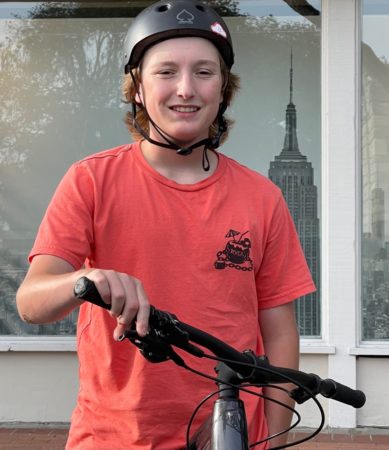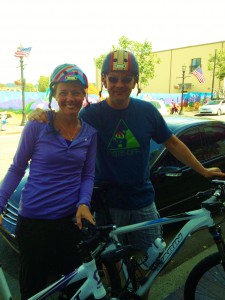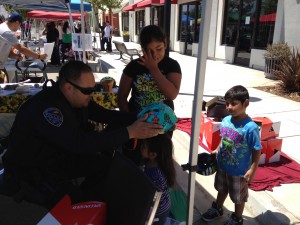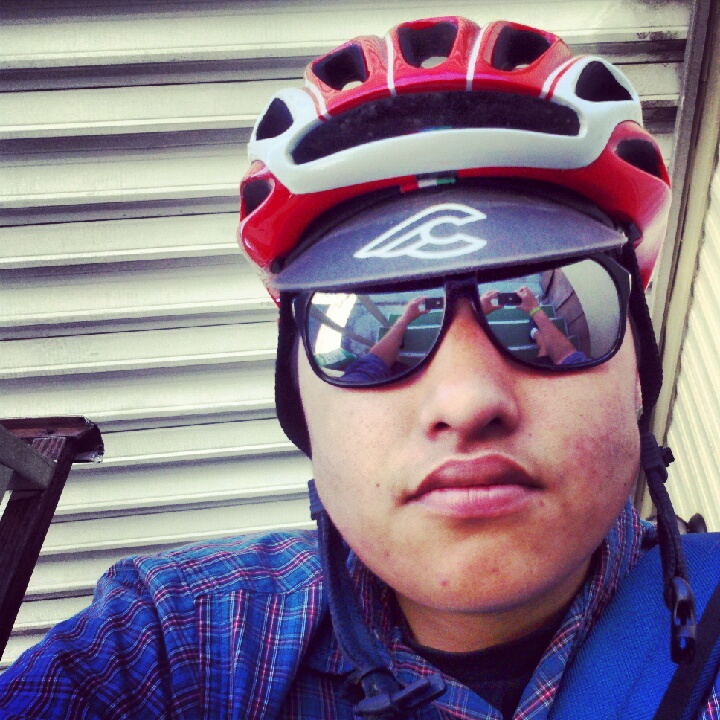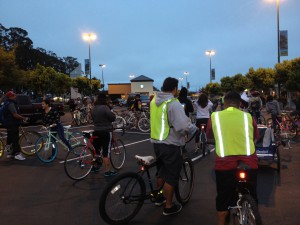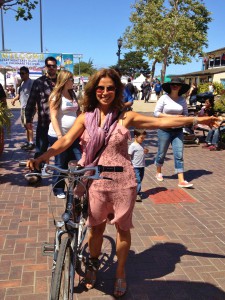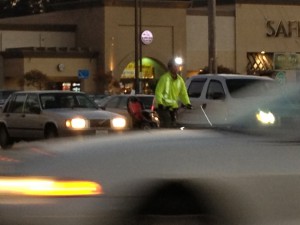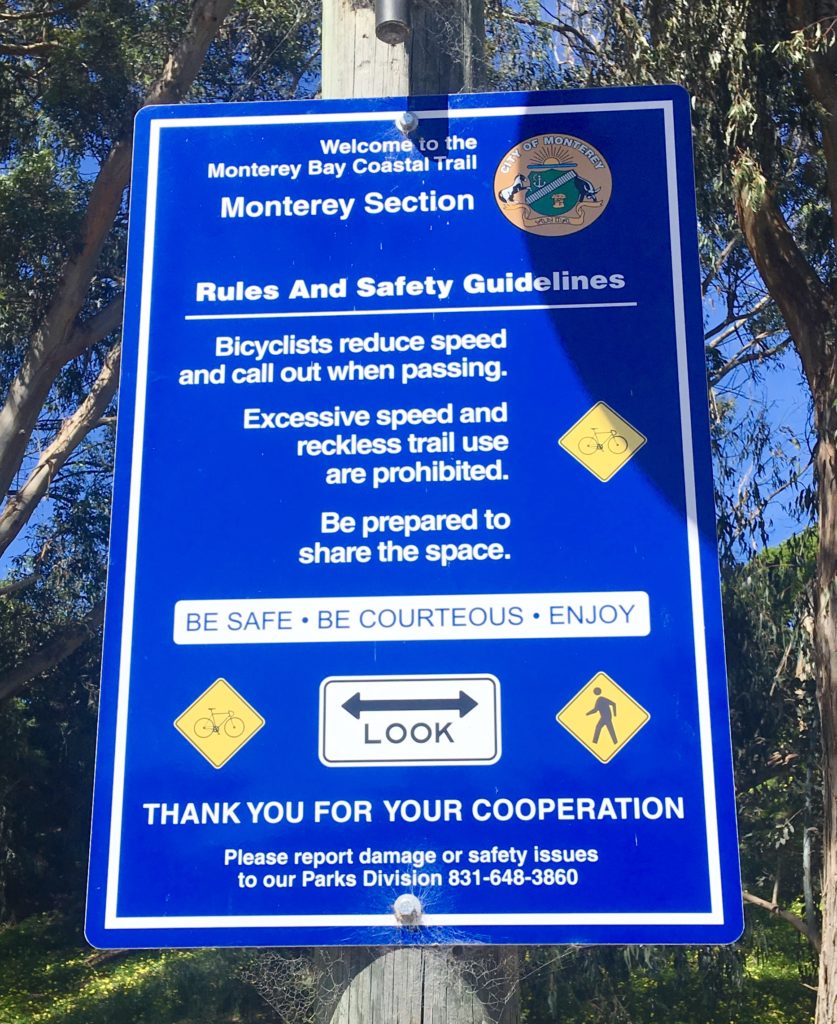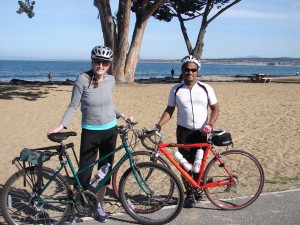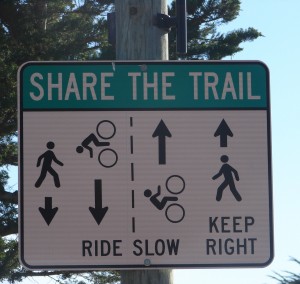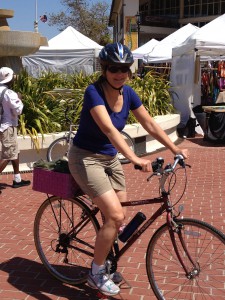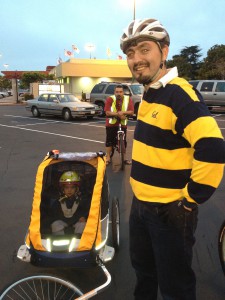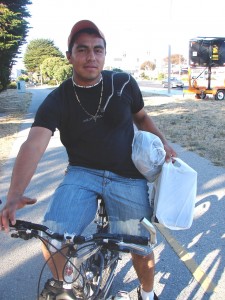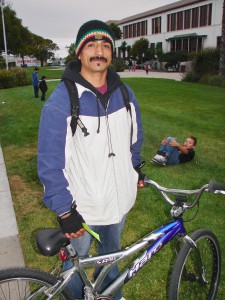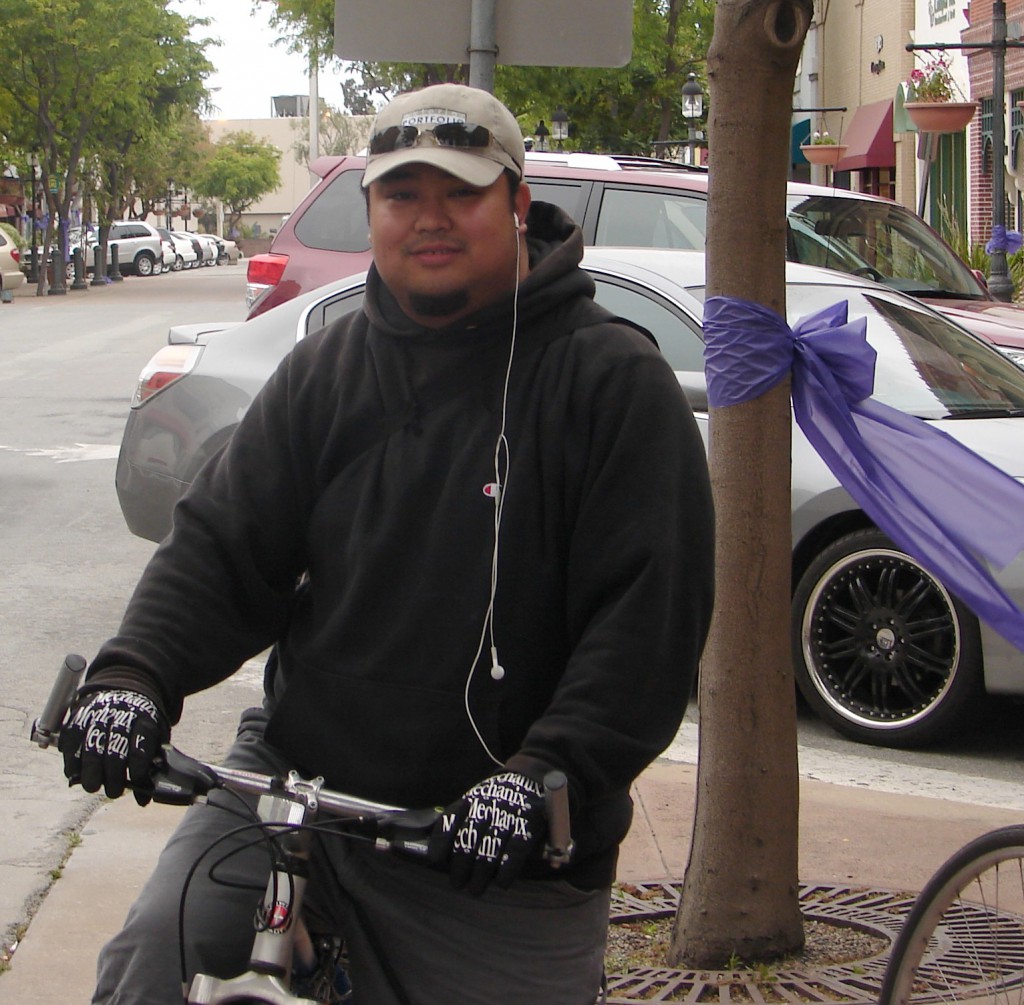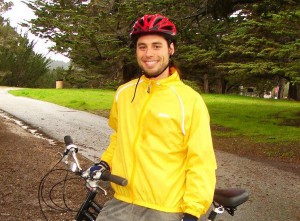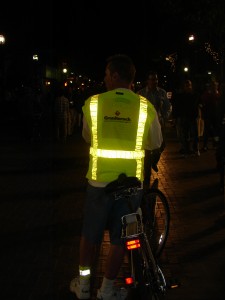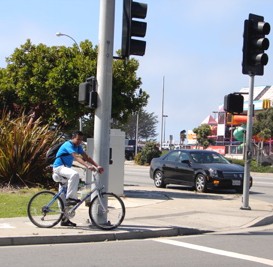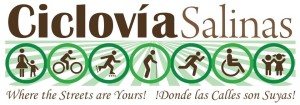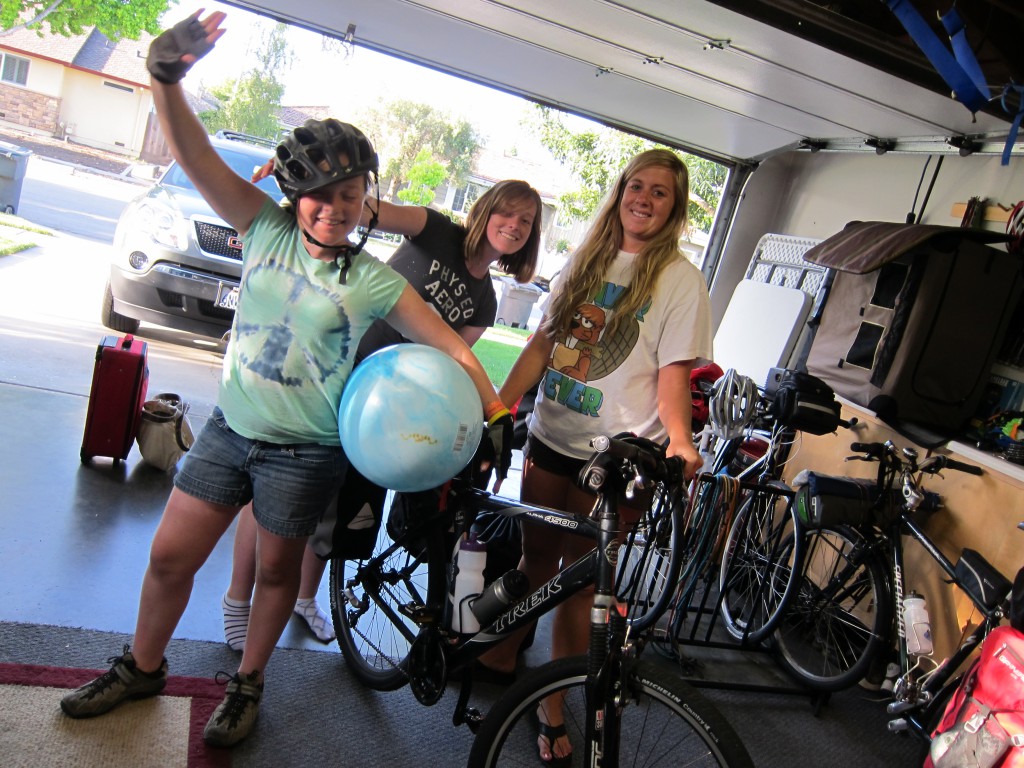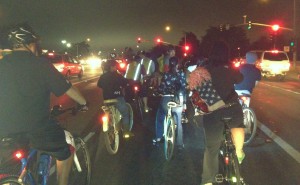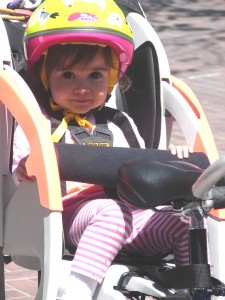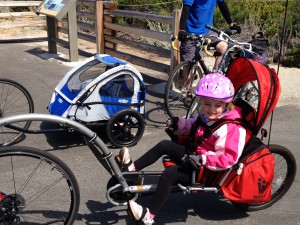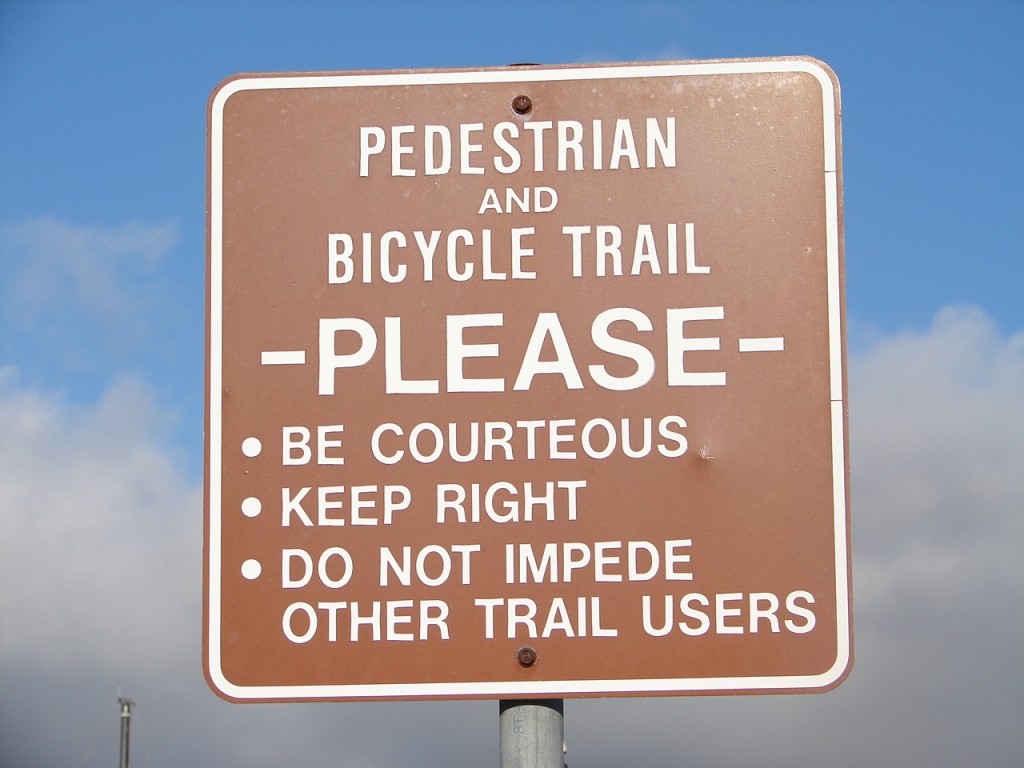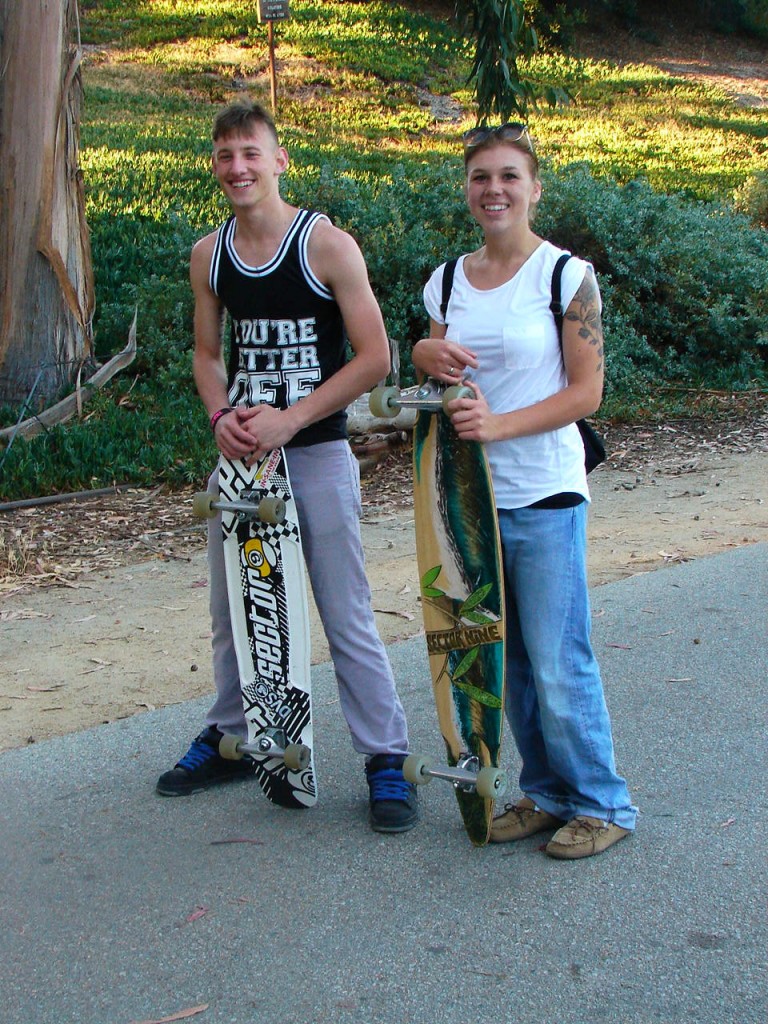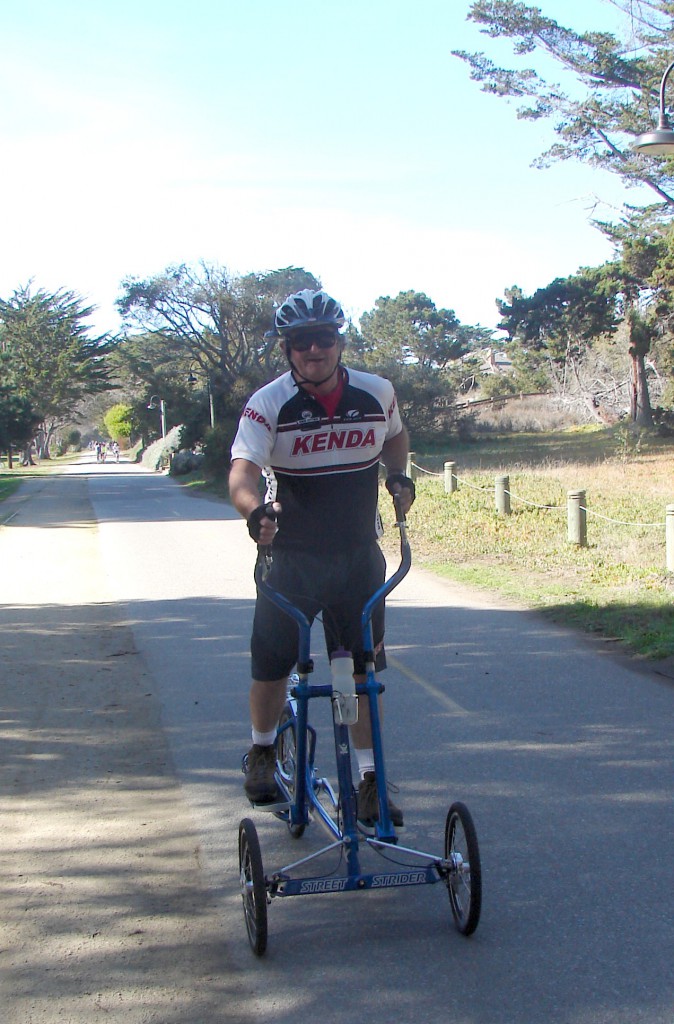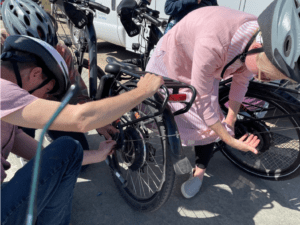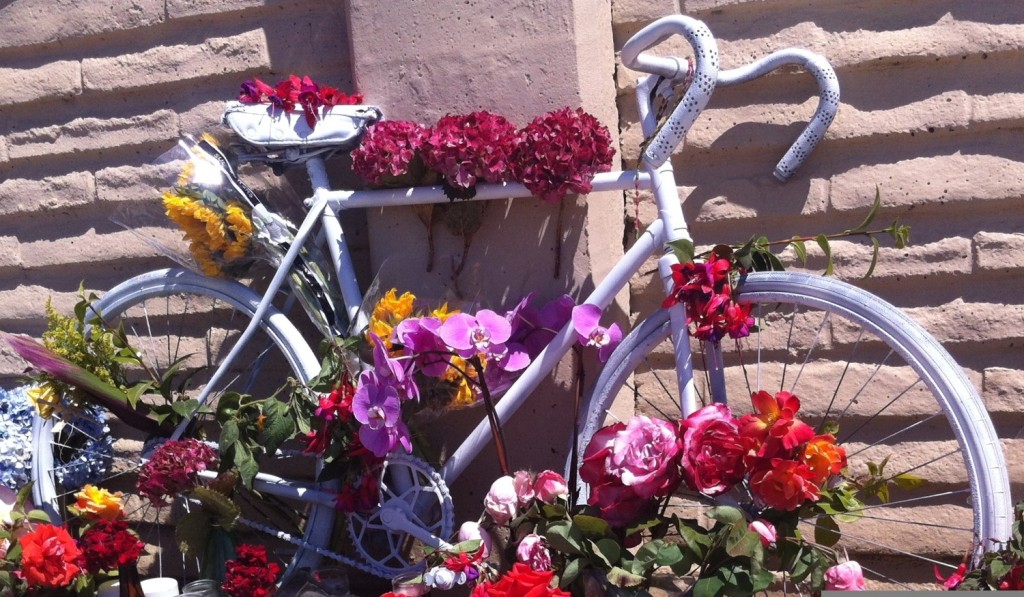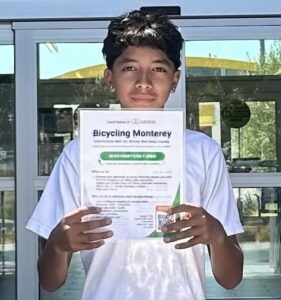3. Bicycle Riding Skills, Bike Safety, and California Bike Laws—for Children, Teens, and Adults
To return to the portal page of the Tips for Bicycling Monterey County 20-section guide, click here. This guide, provided as a public service, was first published in 2009, with many subsequent updates. For additional updates, or if you have questions, please contact us or the sources referred to.
This section of the guide includes tips for people who bike in all parts of California as well as tips specific to Monterey County (including about local bike ordinances). Much of the info is also relevant for people who bike anywhere. For a list of our primary links on this topic, click here.
This section of the guide has 33 parts, covering a variety of topics. Make use of your browser’s “find” window (e.g., on Macs, use Command + F; on PCs, use Control/Ctrl + F). Can’t easily find what you’re looking for? Feel free to phone us anytime.
All information is provided as a public service. No claim is made or liability accepted for its use. For the most accurate and current info, check with the sources referred to.
First, what makes biking safer?
-
Infrastructure improvements.
-
An increase in the numbers of people who bike.
-
Responsible actions of people who drive, bike, walk, skate, scoot, or otherwise get about.
-
Effective laws and law enforcement.
Learn more about all those contributing factors in this section or elsewhere on the Bicycling Monterey website, or phone Bicycling Monterey with your questions.
This section is divided into 33 topics about riding skills, safety, and bike laws.
How to quickly locate a word or phrase on this or another web page? Use your browser’s “find” window (e.g., on Macs, use Command + F; on PCs, use Control/Ctrl + F).
Bicycle Riding Skills, Bike Safety, and CA Bicycle Laws—for Children, Teens, and Adults
Scroll down to check out all 33 topics:
-
California Bicycle Laws and related resources
-
Cell phones and texting—rules for minors and adults
-
How to avoid getting hit, e.g., how to avoid a “right hook,” a “crosswalk slam,” a “wrong-way wreck,” and more—includes a collection of videos (plus much related info below)
-
League Cycling Instructors (LCIs), and riding skills and safety instructional videos, booklets, etc.— also, online bicycling education classes
-
What’s the scoop on helmets—for adults, for minors, and for e-bike riders?
-
Consider high-visibility apparel and accessories
-
Use hand signals (and teach your children)
-
Riding on roadways: How to make those turns, taking the lane, using a bike box, rumble strips, dealing with gridlock, and more—including “Why do you ride like that?” Note well the crosswalks info too, as well as group ride tips and etiquette.
-
Intersections: Eye contact, proper lane usage, and more
-
Mirror
-
Bells, horns
-
Share the trails–for harmony and safety / share-the-trail etiquette and regulations
-
Keep hands free for steering and signaling; also cargo and kickstands
-
Gloves
-
Spoke hazards
-
It’s the law: Keep one ear unplugged
-
Biking in the rain
-
Alcohol and bicycle safety
-
Biking in the dark
-
Bicycles on sidewalks: Safety, teaching children; plus local ordinances/regulations for Monterey County cities and unincorporated areas. (Note: Besides sidewalk ordinances, some local cities have other bike-related local ordinances too, e.g., some restrict pedicabs. Included are links where you can get additional info; look below for “Local ordinances about bicycles on sidewalks, plus other local bike-related ordinances (for Monterey County communities).” Also included: street etiquette for Monterey County’s Open Streets aka Ciclovia events.
-
Children, teens, and family cycling
-
Stay legal on the street, including
- Single file or side-by-side?
- Required equipment (also addressed in topic #1)
- Proper lane usage
- And beyond legalities, learn about bike etiquette or “biking polite”
- Ticketed because you broke a bike law? Info is included about California’s diversion program AKA “bike traffic school,” authorized by AB 902.
- Are you a law enforcement professional who might benefit from a refresher on CA bike laws or Monterey County ordinances? There’s info here relevant for you too.
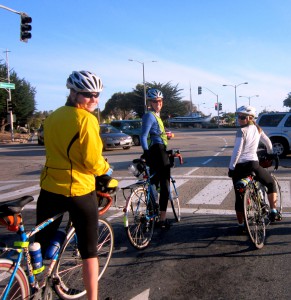 Photo above, in City of Monterey, provided courtesy of Ride America for Safe Routes.
Photo above, in City of Monterey, provided courtesy of Ride America for Safe Routes.
-
Avoiding the door zone / “dooring”
-
What about freeways and bridges?
-
Emergency contact info; also, first aid tips for smartphone users
-
Taking responsibility for personal safety
-
Special considerations for e-bikes / eBikes and other non people-powered bikes
-
Local, state, and national resources: Help improve infrastructure for safer bicycling
-
Biking with a dog
-
Street harassment and bullying
-
Eye protection
-
Special considerations: skirt guards
-
Special considerations, for e-bikes and traditional bicycles: speed wobble
-
Links to DMV Vehicle Code regarding bicycles
* * *
Short of time?
Taking time to review safety tips, and to sharing them with children and teens you bike with, may save a lot of time—time recuperating from a crash (AKA “accident”). Scroll down this page to read the topic headers, stopping to read about topics you may not be knowledgeable about.
Then go have fun on the bikeways!
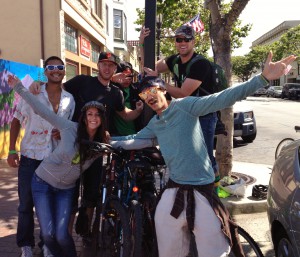
 California bike law summary in English (8.5 x 11 flyer)
California bike law summary in English (8.5 x 11 flyer)
 Leyes de ciclismo de California (bilingual, 8.5 x 11 flyer)
Leyes de ciclismo de California (bilingual, 8.5 x 11 flyer)
Help others find these resources:
- Posters, flyers, etc.: There are a variety of other posters and fliers that direct people to this site.
- On social media? You may wish to copy and post on your timeline: “Bicycle Riding Skills, Safety, and California Bike Laws”— tips from bikemonterey.org and a link to this page or its short link, https://bit.ly/SkillsSafetyLaws.
- All other sharing: Respect copyright (click for details).
Special thanks to the following two Monterey County bike advocates for their volunteer time in support of this section of the Tips for Bicycling Monterey County guide.
Cath Tendler-Valencia (shown with Jan Valencia)
and Frank Henderson.

Find info of value on this site?
Contributions appreciated. Click here to learn more.
Biking on Highway 1 in North Monterey County
How to find tips quickly
Use your browser’s find window to locate all references to a particular topic on this web page. For example, find “lane” for tips on how to “take the lane,” proper lane usage, right-turn lane, left-turn lane, and more. Can’t quickly find what you’re looking for? Feel free to phone Bicycling Monterey for help.Got kids? See the age-specific recommendations and other tips under the “Children and teens” header below.
Need Spanish resources?
Mas información en español? Click here. You’ll find links to many Spanish-language bicycling safety and other resources.
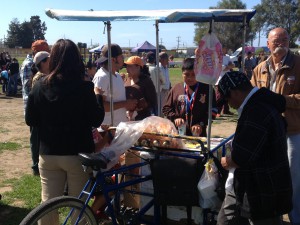
Gently offer to teach others out on the bikeways
As appropriate, and in a kind manner, you may want to share info with others who are still learning California bike laws. Some people may have come from another state or country where the laws are different. Examples:
- There are “bike yield” / “Idaho stop” / “safety stop” laws in many places around the world. Such laws are in place in some U.S. states, including but not limited to Idaho, Oregon, and Washington. For the California legislative effort, see a 2023 update: https://bikemonterey.org/bicycle-safety-stop-for-california.html
- In some countries, the law is that people who bike and people who walk (aka pedestrians) are both to travel against motor vehicle traffic. However, in the U.S., people who bike are to travel with the flow of motor vehicles, although pedestrians are to travel against the flow.
And even within CA, local ordinances may vary. For example, see “Be alert for local signs” under “Share the multi-use trail” below. Another example is that California law leaves it up to local jurisdiction whether or not people may bike on sidewalks; learn in this section about Monterey County’s sidewalk regulations and other local ordinances, plus the pros and cons of sidewalk riding with regard to safety.
Happy biking!
Above, a presentation at a South Monterey County School. Photo courtesy of Ride America for Safe Routes.
Besides helping people bike safely, this section also helps keep the local bike scene cool by providing info so people know how to roll in harmony with the law. Our Constables of the Peace are typically helpful in Monterey County, preferring education to citation. Make their job easier, and be a good ambassador for the bike community, by brushing up on bike laws, provided below. Feel free to contact us with any questions.
* * *
1. California Bicycle Laws, and related resources
In addition to bike laws that apply throughout the state, be aware that some regulations vary from county to county, and even within counties. Use additional resources to become knowledgeable about local regulations where you ride. Check with CalBike’s local partners — http://www.calbike.org/about_us/who_we_are/local_partners/— to learn about local ordinances on sidewalk riding and more.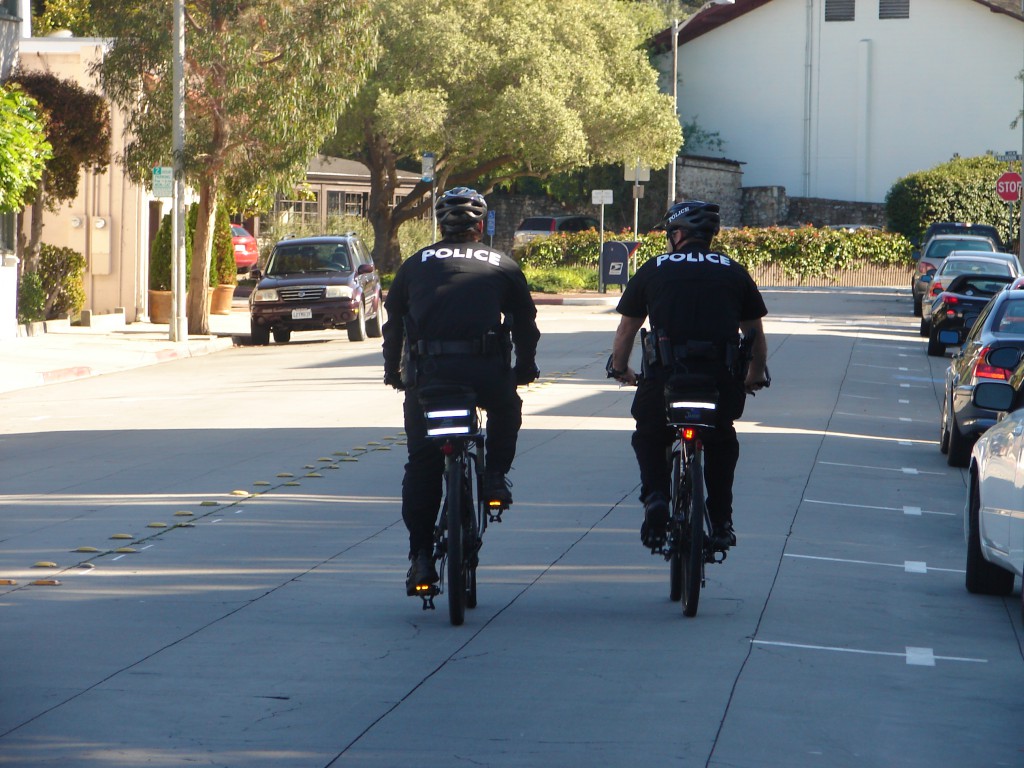
City of Monterey Community Action Team officers. Click here to “See them in action.”
Click here for examples of how Monterey County law enforcement is backing you up in biking safely.
In addition to Bicycling Monterey’s bike law summaries, here is a CA bike law summary from California Bicycle Coalition:
CalBike’s key sections of California Vehicle Code:
https://www.calbike.org/go_for_a_ride/california_bicycle_laws/#laws
(And below, get the full scoop from the California DMV.)
The California Department of Transportation (Caltrans) website also has a summary of bike laws “in plain language.” Caltrans – CA bike laws in plain-language-20120811
The Full Scoop on California Bicycle Laws: California DMV
Source (link confirmed Oct 10, 2023): https://leginfo.legislature.ca.gov/faces/codes_displaySection.xhtml?sectionNum=21212&lawCode=VEH
Some DMV resources on this page will lead to broken links due to DMV site redesign and DMV moving some info to other sites. Please be a community reviewer or volunteer to help fix the many broken links that have resulted from this change.
For now, start with DMV’s Bicycle Resources. (Note: As of May 6, 2017, CA DMV now uses Google translate; click here for DMV’s Bicycle Resources page, then access their translate button at lower right.)
- Although bicycles aren’t motor vehicles, their operation and equipment requirements, etc. are addressed by the California Department of Motor Vehicles (DMV). Bikes are treated like motor vehicles (e.g., if you are riding on a public street, ride in same direction as motor vehicle traffic, like a motor vehicle–don’t travel against traffic, like a pedestrian). In most cases, you are only treated as a pedestrian if you are, e.g, walking (not riding) your bike, such as through a crosswalk. Related update: The California Bicycle Coalition has stated, “It’s often safer for people on bikes to cross an intersection during the pedestrian walk signal if that phase differs from the green light for cars. The OmniBike Bill [AB 1909] makes this safe choice legal.” On September 16, 2022, California Assembly Bill 1909 (Friedman-Haney-Portantino) was signed by the Governor. Among its bike-related provisions, it amends CA Vehicle Code Section 21456. See details, as well as when this and other bike-related provisions of AB 1909 become effective: https://leginfo.legislature.ca.gov/faces/billTextClient.xhtml?bill_id=202120220AB1909
- The DMV website includes a Fast Facts page, “Sharing the Road (FFDL 37) – Safety Tips for Bicyclists and Motorists.” Spanish speakers: That DMV page is also available in Spanish, Compartir el camino (FFDL 37).
- The DMV’s California Driver Handbook on Sharing the Road includes a section on bicycles; click here. Spanish speakers: That DMV page is also available in Spanish.
- Thanks to California Bicycle Coalition for their helpfulness resulting from their 2016 website redesign. You can access the most relevant California Vehicle Codes (in their new location) on Cal Bike’s “California Bike Laws” page; click here.
- Cal Bike’s page is especially appreciated because Bicycling Monterey has multiple links in this section that directed to the DMV website for California Vehicle Code pertaining to bicycles (e.g., we said: for links to all Vehicle Code sections, click here). Unfortunately, the State of California moved that info to a different website, which resulted in many broken links. The California Vehicle Code is no longer available on the DMV website. DMV site visitors are now referred to California Legislative Information to view the California Vehicle Code. Volunteer to help Bicycling Monterey fix the many broken links that have resulted from this change. Meanwhile, start with CA Codes, Laws, and Regulations. Also see DMV’s Bicycle Resources. ) Vehicle Code sections include such things a “Operation on Roadways,” proper lane usage for bicyclists (click here, and scroll down too), equipment requirements/required equipment for day or night riding. Clarification on some of these topics will be found on this Bicycling Monterey web page. (Spanish speakers: Lo siento. As of 20 May 2013, these DMV links lead to “Disponible sólo en inglés” message. However, Bicycling Monterey’s en español page includes Spanish-language bike resources too, including a summary of laws for California bicyclists that include the DMV’s “Equipment Requirements.” You may download it here also: Leyes de ciclismo de CA – Laws for bicyclists in CA (Spanish, English) – Summary
California Highway Patrol
The CHP provides a “Bicycle Riding” pamphlet, in English and Spanish, that covers common causes of bicycle crashes, theft precautions, the laws, equipment requirements, safety tips. Click here for the CHP web page, where you can download the most current versions (often more current than local CHP offices may have on hand).
Start Smart – for Drivers
The CHP cares about helping Californians share the road safely, whether they are driving or biking. That’s why Start Smart began in Monterey County in 2002. It targets youth ages 15-19, and their parent/guardian. It is so valuable it expanded into a statewide program. To learn when the next Start Smart sessions take place, contact your local CHP office. Or to ask questions about Monterey County classes, contact Officer Rios, 831-796-2197.
Among the tips for drivers that Officer Rios shares with Start Smart students is the following law–which he gave Bicycling Monterey a heads-up about the day it was signed by Governor Brown:
As reported in Capitol Alert on 9/23/13, effective September 16, 2014, California drivers are required to give bicyclists at least three feet of space when passing on a California roadway. [Update: Assembly Bill 1909 (Friedman-Haney-Portantino), signed by the Governor on September 16, 2022, amends CA Vehicle Code Section 21760 to further require drivers of motor vehicles to change lanes when passing someone on a bicycle whenever feasible, just as they would if passing a car. That law goes into effect January 1, 2023. See details, as well as other bike-related provisions of AB 1909: https://leginfo.legislature.ca.gov/faces/billTextClient.xhtml?bill_id=202120220AB1909].
For more discussion of CA bike laws
Use your browser’s “find” window to search for “law” on this web page.
Also, League of American Bicyclists “Legal Program and Bike Laws” page includes some highlights for various states, including California.
This little girl knows that at Sports Center Bicycles, Seaside, she can often find a Spanish-speaking employee who will help her keep her bike running safely. For other Monterey County bike shops with Spanish speakers, see Bicycling Monterey’s en español page.
2. Cell phones and texting
Bicycling Monterey encourages reading the comment from League of American Bicyclists cycling instructor Tom Cassera in the following post:
http://www.santacruzlive.com/streetsmarts/2009/09/28/cycling-expert-questions-street-smarts-on-hands-free-cell-phone-law/
Distracted driving laws are highlighted, with accompanying photos and video, on the Bicycling Monterey site; click here. Just as people on bikes want drivers and pedestrians to get off their mobile phones and pay attention, the same need holds true for people on bikes: Please, hang up and bike!

3. How to avoid getting hit
Unfortunately, just knowing and following the law isn’t enough to ensure your safety.
There are excellent tips on “How not to get hit by cars” at BikeSafe.com (https://bicyclesafe.com/) including how to avoid a “right hook,” a “crosswalk slam,” a “wrong-way wreck,” and more. (Thanks to Devian Gilbert for bringing these to my attention.)
For visual demonstrations of right-hooks, left-hooks, challenges with sidewalk riding, and more, see I Am Traffic’s video collection. (Thanks to People Power of Santa Cruz for bringing those to my attention.)
Excellent teaching materials are available from Commute Orlando, thanks in large part to the work of Keri Caffrey. See their Smart Moves. Thank you to Fred Oswald, a League of American Bicyclists (“Bike League”) League Cycling Instructor from Ohio, for alerting me to Commute Orlando’s work.
John S. Allen’s book Bicycling Street Smarts: Riding Confidently, Legally, and Safely has been adapted for various locations, and there is a California edition.
And from the U.K.’s Bike Radar, “14 tips for safer city cycling,” a 7/19/17 piece by Oli Woodman and Colin Levitch, provides a quick summary of value.
Big trucks and buses
Ecology Action of our neighboring county of Santa Cruz prepared the following PDFs: tips for people who bike near big trucks (and buses), and tips for people who drive such vehicles near bikes. These tips are relevant for other locations too. For example, the 2/15/15 “We Could Car Less” column in the Californian mentioned truck traffic on Abbott Street, Salinas.
- For commercial drivers, in English: http://www.ecoact.org/PDF/TrafficSafety_Flyer.pdf …
- Para los conductores de vehiculos comerciales, en español: “INFORMACIÓN SOBRE LA SEGURIDAD DE LOS CICLISTAS PARA LOS CONDUCTORES DE VEHÍCULOS COMERCIALES” http://www.ecoact.org/PDF/TrafficSafety_Flyer_spanish.pdf …
- For bicyclists, in English: “Sharing the Road Safely with Trucks and Buses” http://www.ecoact.org/PDF/bike_safety_trifold.pdf …
- Para ciclistas, en español: “compartiendo las calles de manera segura con camiones y autobuses” http://www.ecoact.org/PDF/bike_safety_trifold_SP.pdf …
Truck alongside bike lane on Camino Aguajito at Fremont,
near Monterey Peninsula College
4. League of American Bicyclists (“Bike League”) certified League Cycling Instructors (LCIs) — plus videos, booklets, etc.
Our fellow California Bicycle Coalition partners up at Bike East Bay have begun offering online classes, in response to COVID-19. Their first class, a 3/29/20 webinar Urban Cycling 101, was free. Check their website for updates: https://bikeeastbay.org/BikeEdOnline
LCIs residing in Monterey County include Frank Henderson (pictured above), since 2005, and others. Refer to Bicycling Monterey’s March 2019 post
“League Cycling Instructors in Monterey County: Who and why.”
Videos:
Videos from the League of American Bicyclists on topics such as lane changing, intersection positioning, signaling, riding on sidewalks, and more are available at http://www.bikeleague.org/ridesmartvideos
Thinking of organizing a bike rodeo/bike skills and safety event? Click here to learn more about LCI Frank Henderson, and to watch an approximately 15-minute video with Frank, interviewed by Transportation Agency for Monterey County’s executive director.
Booklets: In Bicycling Monterey’s direct outreach by bike, we often distribute Spanish and English copies of the League’s “Smart Cycling Quick Guide” booklets.
- The 24-page Quick Guide covers just about everything you need to know to ride a bike safely and confidently. However, bike laws vary around the USA, and elsewhere, so use additional resources to become knowledgeable about local regulations where you ride. For California-specific info, refer to the California Bicycle Coalition’s local partners: http://www.calbike.org/about_us/who_we_are/local_partners/. Refer also to Bike Safe California (bikesafecalifornia.org), a project of CalBike.
- To order the Quick Guide booklets from the League, go to http://bikeleague.org/smartcyclingresources.
- The Spanish version became available in 2015. Available editions (per League website as of March 2019) include Korean, Vietnamese, Russian, and Khmer, in addition to Spanish and English.
5. What’s the scoop on helmets?
To avoid a ticket (beginning in 2019, a “fix-it” ticket), California law requires helmets for minors (people under 18). For full details, including about fix-it tickets, refer to CA Vehicle Code 21212. The following text is merely an excerpt from http://leginfo.legislature.ca.gov/faces/codes_displaySection.xhtml?sectionNum=21212.&lawCode=VEH: “(a) A person under 18 years of age shall not operate a bicycle…nor ride upon a bicycle…as a passenger, upon a street, bikeway, as defined in Section 890.4 of the Streets and Highways Code, or any other public bicycle path or trail unless that person is wearing a properly fitted and fastened bicycle helmet that meets the standards of either the American Society for Testing and Materials (ASTM) or the United States Consumer Product Safety Commission (CPSC), or standards subsequently established by those entities. This requirement also applies to a person who rides upon a bicycle while in a restraining seat that is attached to the bicycle or in a trailer towed by the bicycle.”
You may also be interested in the following media report by Samantha Solomon, “What parents should know about California’s new helmet safety laws: AB-2989 and AB-3077 are changing helmet laws for electric scooter riders and bikers. Find out what’s new in 2019,” published by ABC10 on Dec 19, 2018: http://www.abc10.com/article/news/local/sacramento/what-parents-should-know-about-californias-new-helmet-safety-laws/103-ff71e394-caef-48f1-9aed-08452201831b
Sure! We’ll fasten those straps before we saddle up!
Because of the name of the Bicycling Monterey project HER Helmet Thursdays, people may think this site promotes helmet use. However, HER Helmet Thursdays is not about wearing a helmet. People have strong feelings about helmet use, pro and con. Bicycling Monterey does share some related stories, to help give people more info on which to base their personal decisions:
- Click here for the League of American Bicyclists/Bike League position paper on the use of protective equipment, including helmets. The League does recommend helmets.
- Visit the Bicycle Helmet Safety Institute website for a wide range of information about helmets: https://helmets.org.
- E-bike riders—even those with a top assisted speed of 20 mph—may wish to consider: https://helmets.org/ebike.htm
- Click here for a nationwide study released in May 2013.
- Click here for a local story.
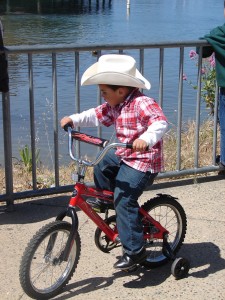 This 2-year-old cowboy, Francisco Dorantes, had his eye on the sea lions below Fisherman’s Wharf. Dad told him, “You can sit on that bike, Cowboy, but you have to swap that hat for your bike helmet before you can ride! That’s the law here in the Wild West.”
This 2-year-old cowboy, Francisco Dorantes, had his eye on the sea lions below Fisherman’s Wharf. Dad told him, “You can sit on that bike, Cowboy, but you have to swap that hat for your bike helmet before you can ride! That’s the law here in the Wild West.”
Below, Mateos of Seaside sporting his fun helmet in March 2025.

Bicycle Helmet Fit Guides
First, an excellent resource for all things helmets is https://helmets.org/index.htm#helmets, which includes some info in Spanish, and French, too: https://helmets.org/spanish.htm
Among bicycle helmet fit guides are those from the reputable sources below. In addition, here’s a “How to set up your helmet” article with helpful photos: https://road.cc/content/feature/how-set-your-helmet-10-easy-steps-perfect-fit-171677
- https://helmets.org/fit.htm
- http://www.nhtsa.gov/sites/nhtsa.dot.gov/files/8019_fitting-a-helmet.pdf
- en español: http://one.nhtsa.gov/people/injury/pedbimot/bike/EasyStepsSpan/index.htm
- http://www.cpsc.gov/safety-education/safety-guides/sports-fitness-and-recreation-bicycles/which-helmet-which-activity
- http://www.cdph.ca.gov/HealthInfo/injviosaf/traffic/Documents/BikeHelmetENG01-VOSP.pdf
- en español: http://www.cdph.ca.gov/HealthInfo/injviosaf/traffic/Documents/BikeHelmetSPAN01-VOSP.pdfF)
Some helmet fit guides recommend one finger under the chin strap, but two fingers are sometimes recommended instead. This is happy news to those people who really don’t like tight straps–and if pressured to do one-finger tightness, would be tempted not to buckle their strap, or to unbuckle it while riding.
Greenfield police officer fitting children in helmets.
Teach children to take off their helmet immediately when they get off their bike. Helmets are not intended for–and may even be unsafe for–other activities. Click here for a warning from the U.S. Scouting Service.
If you’re renting a bike, a helmet is usually included. Helmets are also sold at local bike shops.
Sixteen-year-old Salinas teen Kyle Beardshear was a very experienced biker. One eve, he clipped his helmet to his handlebars shortly before he hit a parked car on North Main. Read Kyle’s story.
Sure, the little guys must wear helmets, by law. But many of the big guys choose to wear them too, including…
Jess Martines, founder of the fixed-gear ride group F.N.B.
and Luciano Rodriguez, an eclectic local cyclist.
Helmets sometimes required for adults
Note that many group rides require a helmet for all ages, even though CA law only requires helmets for people under 18. See a sampling of Monterey County ride rules and etiquette later on this web page.
Some specific locations also require helmets for adults. One example is the Mazda Raceway Laguna Seca track, where Twilight Rides take place. Another is the Naval Postgraduate School campus.
6. Consider high-visibility apparel/accessories
In an ideal world, bike infrastructure is perfect, and all drivers are aware of and extra cautious around people on bikes. Since the world isn’t ideal, it can’t hurt–and may help–to use high-visibility apparel and accessories at times you deem it appropriate.
Two of the most important things you can do to stay safe on your bike: be visible and predictable.
So, what about being visible? Especially when leaving off-road bike paths to share a road with cars, consider dressing to be highly visible. (Nah, that doesn’t mean showing skin.)
If you don’t have some type of neon/brightly colored shirt or jacket, you may want to purchase brightly colored biking apparel or a reflective sash that can be worn over any clothing. Even on a bright, sunny day, simply passing under the shade of trees can often make a person on a bike nearly invisible to cars. If you ride bent over, sitting upright if you hear a car approaching will make your high-visibility apparel more noticeable to that driver.
Remember other safety gear, as appropriate, such as lights; see “Biking in the Dark” section.
Refer to the “More Bike Safety Gear: High Visibility” section of this guide. There, and on the “Bike Shops in Monterey County” page, you’ll find links to Monterey Bay locations where you can purchase such items.
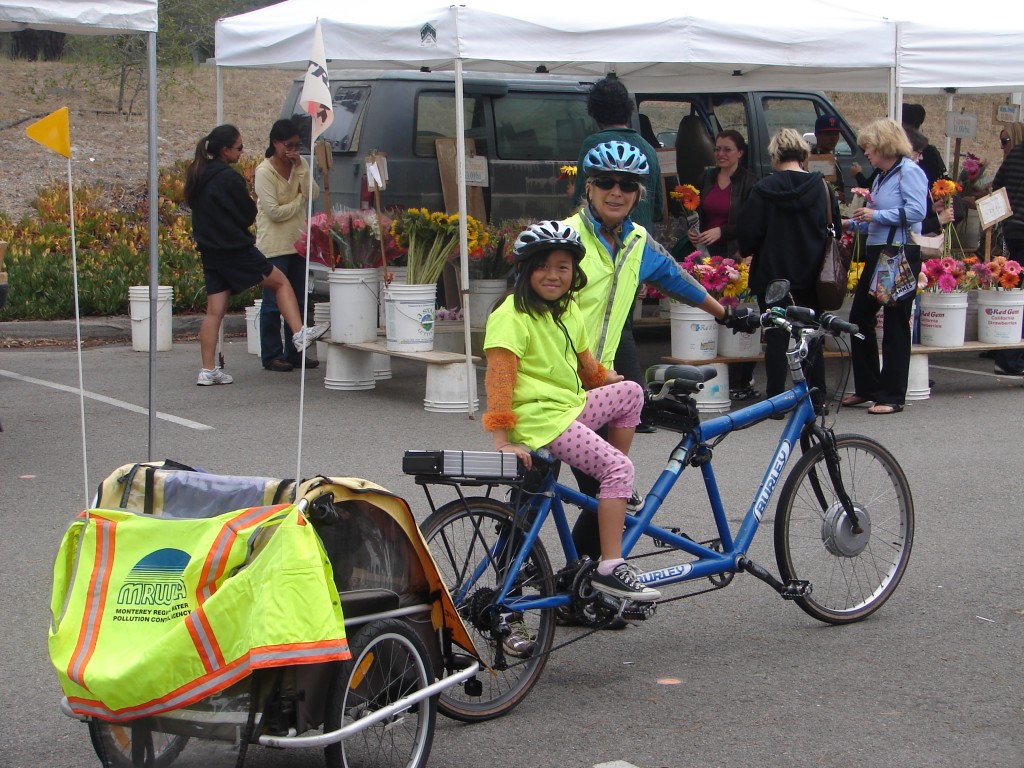 Susan Ragsdale-Cronin and daughters Dharma Maria (in trailer) and Tara can be seen biking all over the Monterey Peninsula.
Susan Ragsdale-Cronin and daughters Dharma Maria (in trailer) and Tara can be seen biking all over the Monterey Peninsula.
7. Use hand signals
Be predictable. Ever feel annoyed by motorists who fail to use their turn signals and just cut in front of you? The same etiquette applies to bicycling—and besides, it’s the law!
Use hand signals to let others know when you’ll be turning left or right, and remember your “brake lights” too, that is, use hand signals to indicate slowing or stopping.
Here’s the related California law, VC 22111 https://leginfo.legislature.ca.gov/faces/codes_displaySection.xhtml?lawCode=VEH§ionNum=22111.). California DMV provides (as of 7/16/25) some hand signaling images under “Be alert and obey all traffic laws” on the following page: https://www.dmv.ca.gov/portal/driver-education-and-safety/special-interest-driver-guides/bicyclists-pedestrians/ . However, NOTE that the California DMV page shows (as of 7/16/25) only one option for signaling a right turn (image shows how to signal a right turn with your left arm), while other resources on hand signaling show two options, e.g., https://www.oregon.gov/odot/DMV/Pages/Online_Bicycle_Manual/Section_5.aspx#Turning. Why does that matter? As BicycleSafe.com suggests in its “General Safety Tips” on “Signal your turns” https://bicyclesafe.com/: If you’re signaling a right turn with your left arm, many drivers have no idea what that means. If you’re signaling a right turn with your right arm, it is more likely to be understood by drivers.
After signaling, it is NOT necessary to keep your hand signal going (e.g., NOT all the way through an intersection)! In fact, to steer your bike safely, do your hand signal, then put that hand back on your handlebar (two hands on handlebars gives you better control of your bike).
You may also want to watch Bike League’s video on Signaling and Scanning: https://youtu.be/WbP-ldo_kGk?si=jPSNZ__CXjuYVP0k.
You bet, when I’m out riding, I signal my intentions!
8. Operation on roadways: How to make turns, taking the lane, and more
California laws include “Operation on Roadway” guidelines. These are sometimes misinterpreted. Review this page and the linked resources, and phone Bicycling Monterey with any questions. The Three Feet for Safety Act brought additional attention to these topics; click here for more from Street Smarts Santa Cruz.
The first (to my knowledge) bike box in the Monterey Bay Tri-County region was installed in summer 2017 at Seabright and Soquel Avenues, Santa Cruz. Wherever you ride, if you come upon a bike box, you may not be sure how to use it. On the City of Santa Cruz website, they offer “How to Use Santa Cruz’s New Bike Box“; however, note that their instructions (as of July 8, 2017) seem a little odd. They say, “Use the new bike box at Seabright and Soquel if you wish to travel straight on Seabright…” when in fact at this intersection (which is a t-intersection), you can’t go straight, you must turn right or left. You may find it more helpful to see details about bike boxes on the National Association of City Transportation Officials website: http://nacto.org/publication/urban-bikeway-design-guide/intersection-treatments/bike-boxes/
The first bike box in Monterey County, according to Transportation Agency for Monterey County staff member Ariana Green, was installed on East Market Street at Towt in Salinas. In spring 2018, Seaside followed suit, as part of their West Broadway Urban Village project.
Rumble strips
Rumble strips are proven to prevent crashes. But they can also pose dangers for people who bike. Adventure Cycling Association has info about rumble strips and best practices for their installation. ACA also offers advocacy help when new rumble strips are planned. Details: https://www.adventurecycling.org/advocacy/national-advocacy-projects/rumble-strips/
Watch a Caltrans video to learn about the flying wedge, a related pavement marking: https://www.youtube.com/watch?v=CY9fiUcAFck&feature=youtu.be
What about crosswalks?
If you aren’t biking in the travel lane, but are instead biking on a sidewalk, please note: To use a crosswalk, hop off your bike and walk it in the crosswalk. That’s right, walk in the crosswalk, just as a pedestrian does, do not bike in the crosswalk. Why? Unless you are in a wheelchair, when you’re on wheels (e.g., biking, skateboarding, skating), you do not have pedestrian status in a crosswalk.
For more on this topic, see “Is the Crosswalk a Safe Way for a Bicycle Rider to Cross the Street?” from Bike Walk Alameda’s Dr. Sprockett; and the “crosswalk slam” section in “How not to get hit by cars” at BikeSafe.com (https://bicyclesafe.com/).
Crosswalks are one area of common confusion and potential danger. If you’re riding a bike, you are operating a vehicle and subject to vehicle laws–thus are generally (note VC 21650-g) prohibited from riding in crosswalks, or on sidewalks. However, in California, sidewalk bike riding is not prohibited statewide, although it may be by local ordinance (see some Monterey County ordinances below–along with safety cautions about sidewalk riding).
- Related update: The California Bicycle Coalition has stated, “It’s often safer for people on bikes to cross an intersection during the pedestrian walk signal if that phase differs from the green light for cars. The OmniBike Bill [AB 1909] makes this safe choice legal.” On September 16, 2022, California Assembly Bill 1909 (Friedman-Haney-Portantino) was signed by the Governor. Among its bike-related provisions, it amends CA Vehicle Code Section 21456. See details, as well as when this and other bike-related provisions of AB 1909 become effective: https://leginfo.legislature.ca.gov/faces/billTextClient.xhtml?bill_id=202120220AB1909
Teach your children to exercise wise judgment about the best way to make turns.
- Especially for children, it is usually safer to hop off the bike and make that turn as a pedestrian: Walk your bike through the crosswalk. (The DMV’s safety tips include tips on making a left-turn that reference the option of stopping and crossing as a pedestrian in the crosswalk [hop off and walk your bike].)
- A bicycle does have the right to make a left-hand turn from the left-turn lane of the road, just as a car does. Do it safely!
Although I bike, I drive too. And I’ve been at the wheel of a car when an adult on a bike not only failed to signal their intention to turn, but also came from the right-hand lane and suddenly biked in front of me to make a left turn. Stories like these are a sober reminder to all of us.
Have 20 seconds–-that might even save your life? Watch Ecology Action’s video on making a left-hand turn safely. (For right turns, see “Intersections” heading below.)
The same page also includes a 33-second video on how to “take the lane” when it isn’t safe for a car and a bike to be side-by-side.
Here’s an excellent animation, shared by Megan Tolbert, Transportation Planner for CSUMB TripWise:
Some people ask about the safety of riding a bike in the travel lane (where cars travel, versus a bicycle lane). Motorists want to know how to pass bicyclists safely. This interactive animation is enlightening for both cyclists and motorists. Keep clicking “continue” until you come to “See the Savvy Cyclist Ride,” and check that out too. http://commuteorlando.com/
Why do you ride like that?
An excellent resource about lane usage comes from the Florida Bicycle Association’s CyclingSavvy web page, “Why do you ride like that?” http://cyclingsavvy.org/hows-my-driving/ Thanks to Bob Shanteau of Velo Club Monterey for sharing that resource. Bob points out that the info about FL law requiring bicyclists to ride “as close as practicable to the right-hand curb or edge of the roadway,” including the law’s many exceptions to this rule, apply to CA law as well.
For California-specific details on lane usage for bicyclists and more, see “Where you can ride” on the California Bicycle Coalition’s web page summarizing California Bicycle Laws.
What about lane splitting? First, what is it? As defined on Wikipedia as of 8/20/16, “Lane splitting is riding a bicycle or motorcycle between roadway lanes of vehicles driving in the same direction. More narrowly, it refers to overtaking slow or stopped vehicles by traveling between lanes. It is also sometimes called lane sharing, whitelining, filtering, or stripe-riding. Alternatively, lane splitting has been used to describe moving through traffic that is in motion. It is similar to filtering, or filtering forward, which is used to describe moving through traffic that is stopped. When the space used is between two lines of vehicles, this is also known as lane splitting; however, filtering can be accomplished by using space on the outside edge of same-direction traffic as well.”
The Bike East Bay website includes “To Filter or Not to Filter: Dealing With Gridlock on a Bicycle.” Tips there are for people who bike, with a few reminders for people who drive too.
Special note: Bicycling Monterey’s fellow California Bicycle Coalition partners at Bike East Bay are offering FREE bicycling education classes online, beginning March 29, 2020. These special webinars are planned to continue through the duration of California’s stay-home order in response to COVID-19. For a list of dates and topics, and to register, visit: https://bikeeastbay.org/BikeEdOnline. They hope to offer these webinars in Spanish and Cantonese too. https://bikeeastbay.org/BikeEdOnline
It’s tempting, but don’t!
When biking on a road with many cars, it’s tempting to “take a break” when there is length of space between parked cars, and to bike there–in the parking lane–until you reach a parked car and must move back into the travel lane. Unless the parked cars are very far apart, such weaving in and out of traffic is a bad idea.
Why? Drivers may not see you when you are ready to go back into the travel lane.
Bob Shanteau suggested this 43-second video from Team CyclingSavvy as a demonstration of communication and effective lane change for bicyclists on a group ride. <http://vimeo.
Group ride etiquette, rules, and tips
You are an ambassador for bicycling whenever you’re out pedaling, alone or on a group ride, on a street or on a trail. Please be a warmly welcomed and respected ambassador. Bike polite!
Of course, riding practices affect personal safety and that of others–people biking, walking, driving, or otherwise getting about. Some California bicycle laws, such as leaving one ear bud out, are especially critical on group rides. It’s recommended that even experienced cyclists review state and local laws, and group ride etiquette.
Yes, usually specific guidelines are provided by organizers of the most successful group rides. Get familiar with guidelines before attending. Many group rides require a helmet for all ages, even though CA law only requires helmets for people under 18.
Here are some examples of group ride etiquette provided by some Monterey County group ride organizers:
- Velo Club Monterey (VCM): https://veloclubmonterey.wildapricot.org/The-Basics-of-Friendly-Riding, https://veloclubmonterey.wildapricot.org/Group-Ride-Etiquette, https://veloclubmonterey.wildapricot.org/E-Bike
- Monterey Off Road Cycling Association (MORCA) riders are to abide by MORCA’s passing etiquette https://morcamtb.org/resources/passing-etiquette/, Spirit of Howdy code of conduct, and International Mountain Biking Association (IMBA) rules of the trail. Resources: https://morcamtb.org/resources/
- Rideout / Bike Party guidelines
- Ciclovia Salinas – in English Ciclovia Salinas Etiquette – last updated for 2019 – en español Ciclovía Salinas – Reglas de comportamiento y la Ley – 2017 horas
Below: Glenn Jacinto was at the first Salinas Bike Party, in August 2012. He is hip to SBP party rules and mindful that following them makes him a good ambassador for the bike community. Glenn knows that when decision makers vote on things like new bike lanes, many will consider the predominate actions of bicyclists they’ve observed, or that the public has reported to them. Decision makers are more likely to say “Let’s have more bike lanes!”–if cyclists have left a positive feeling.
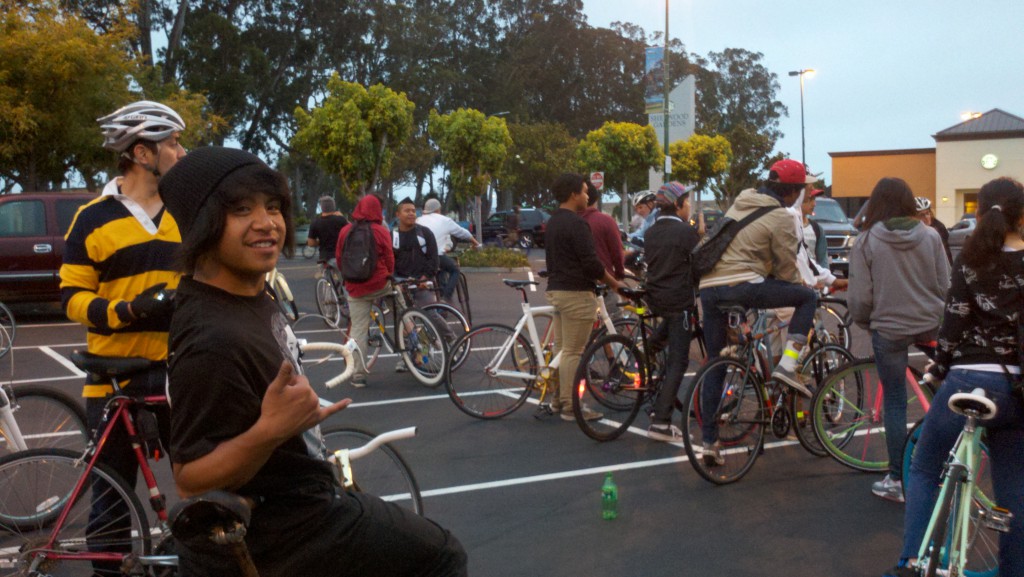 Below: Tim Meehan, the Monterey County bike commuter dad shown at Canyon Del Rey/Highway 218 and Fremont in Seaside is super savvy about lane usage for bicyclists (click here, and scroll down too). Tim also serves on the Transportation Agency for Monterey County’s bicycle and pedestrian advisory committee.
Below: Tim Meehan, the Monterey County bike commuter dad shown at Canyon Del Rey/Highway 218 and Fremont in Seaside is super savvy about lane usage for bicyclists (click here, and scroll down too). Tim also serves on the Transportation Agency for Monterey County’s bicycle and pedestrian advisory committee.
9. Intersections: Eye contact and proper lane usage
About the photo below: Yes, we were happily able to pass by all these motor vehicles stopped in traffic, because we were on our bicycle! We were able to pedal past them, in the bike lane—albeit slowly, using extra caution (in case some driver grew impatient and illegally pulled into the bike lane). But how did we handle the busy intersection up ahead? Due to the heavy traffic of this day’s rush hour, when we reached that intersection, we chose to hop off our bike, press the pedestrian crossing signal, and walk our bike through the crosswalk.
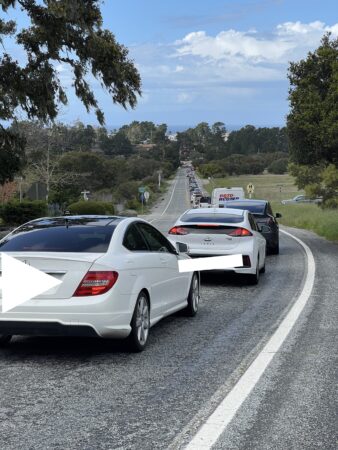
Note: On Sept 4, 2019, California Governor Newsom signed AB 1266, which, as the bill’s author stated, “will make our roadways safer for everyone by matching street design with the already practiced, safe behavior of cyclists at busy intersections.” As the executive director of the California Bicycle Coalition summarized, “This bill authorizes a bicyclist to travel straight through a right or left-hand turn only lane and requires Caltrans to develop standards for lane striping, pavement marking, and appropriate regulatory signs to implement this bill.” Learn more: https://www.calbike.org/governor-signs-ab-1266/
When crossing straight through an intersection, or when making either a right or left-hand turn, make eye contact with nearby drivers whenever possible. Be a safe, predictable bicyclist by hand signaling and by following California DMV guidelines about lane usage for bicyclists (click here, and scroll down too).
What if you’re not comfortable making a turn in the travel lane with cars? Then use the crosswalk at an intersection–temporarily hop off your bike and walk it, following the same laws that govern other pedestrians. As mentioned above, that is usually the wisest way for children to get through an intersection, and at times, such as at the busiest intersections, it can be the smartest option for adults too. That’s why the DMV’s safety tips for bicyclists and motorists sharing the road include that option in their tips on making a left-turn (scroll down to “Using Crosswalks”). When the DMV states you may choose to “cross as a pedestrian in the crosswalk,” please understand that means get off your bike and temporarily be a pedestrian. Walk your bike in the crosswalk, don’t ride your bike in the crosswalk.
Related update: The California Bicycle Coalition has stated, “It’s often safer for people on bikes to cross an intersection during the pedestrian walk signal if that phase differs from the green light for cars. The OmniBike Bill [AB 1909] makes this safe choice legal.” On September 16, 2022, California Assembly Bill 1909 (Friedman-Haney-Portantino) was signed by the Governor. Among its bike-related provisions, it amends CA Vehicle Code Section 21456. See details, as well as when this and other bike-related provisions of AB 1909 become effective: https://leginfo.legislature.ca.gov/faces/billTextClient.xhtml?bill_id=202120220AB1909
Be especially cautious that you are not to the right of a car that is making a right-hand turn when you are going straight. Refer to “Collision Type #5: The Red Light of Death” in the aforementioned “How not to get hit by cars” at BikeSafe.com for tips about this.
Also see “Making right turns in the presence of bicyclists” in Street Smarts Santa Cruz.
As Ariana Green of the Transportation Agency for Monterey County told KION 3/18/15, “One of the most common collisions between bicyclists and drivers are when drivers are turning right and don’t think to look for the cyclist that’s right there and may be in their blind spot.” That’s one reason TAMC has added green lanes on Davis Road, Salinas and Imjin Parkway, Marina and plans to add more on Imjin, along with adding green lanes on West Alisal Street and Lincoln Street in Salinas. Learn more about green lanes on the People for Bikes Green Lane Project website.
10. Mirror
Use of a rearview mirror is far from a unanimous practice of people who bike. While not a bicycle equipment requirement by California law (as of January 2025), many riders find having a rearview mirror is helpful.
There are companies selling rearview mirrors of various types, e.g., bar-end, handlebar-mounted, helmet-mounted, glasses-mounted. One popular type that is reasonably priced is the Take a Look mirror: https://takealookactive.com/
In 2025, in part due to increasing numbers of electric cars (their quietness means you often don’t hear one approaching from behind), we got a pair of TriEye glasses. They have an integrated mirror in the lower corner of the lens that allows seeing behind you with a tilt of your head. Of course they take a little getting used to; for most users, they soon they feel natural. For more info, visit https://trieye.com/.
In the early years of the Monterey County Youth Center bike repair and safety class (launched by Bicycling Monterey in 2012), we asked one of the instructors, Frank Henderson—who has over twenty years and over 50,000 miles of roadway cycling experience—for his recommendation about the best rearview mirrors. Frank likes his bar-end rearview mirror, which he got from CycleAware, a business formerly based in Pacific Grove.
11. Bells and horns
On mountain bike trails
Members of Monterey Off Road Cycling Association are among mountain bikers who have the “Spirit of Howdy.” When you hear a MORCA member ringing a bell on a mountain bike trail, it isn’t meant as a pushy “clear the way” message to hikers and other trail users. Instead, it’s intended as a helpful “I’m here” communication. (Beyond bell or horn use, if you mountain bike, please also join MORCA members in abiding by the Spirit of Howdy code of conduct.)
On roads
“Same road, same rules, same rights.” That includes the California DMV rule that states “Do not honk your horn unless it is a safety warning to avoid a collision.
That’s the advice for all vehicles on a public road, including bicycles. Reserve use of a bicycle horn on roads as an alert for those times when safety demands it. Having a horn equipped on your bike is a good idea, if used judiciously/legally. Safe biking practices, including proper lane usage, hand-signaling, and more will do far more good than blasting a horn.
Besides, chances are a careless driver may have music, etc. up too loud to hear a bike horn anyway. If bike horns sounded like car horns, perhaps more attention would be paid.
For those occasions when judicious use of a horn is in order, to avoid a collision, you may want to check out the Loud Bicycle horn. It is engineered to get a driver’s attention, because it sounds just like a car horn. Here’s what the Loud Bicycle company write: “Drivers react to car horns before they even know where the sound is coming from. A driver that gets beeped at while backing out of a driveway for example, will immediately brake. These kinds of reflexive reactions are perfect to keep cyclists safe.” Visit LoudBicycle.com if interested in their horn.
Horns/bells on multi-use trails
You may wish you had–or maybe you do have–a loud horn to blast the ears of someone stepping (or biking) in your way on the multi-use trail. Infrequently, safety may dictate using a bell or horn on the trail to avoid a collision. However, in most cases, it’s appropriate to restrain yourself; resist the temptation to use the bell/horn to chastise an errant traveler. (Read more about share-the-trail harmony below.)
An old-style bicycle horn with a friendly sound has been part of my bike equipment. It’s fun for little kids to squeeze that horn when I stop to chat with them and their parents. Rarely do I use even my soft, friendly horn on the trail as an alert. I prefer to be extra cautious around others. As appropriate, I call out a howdy to them in a friendly voice, or “Passing on your left.”
Some people on bikes ring bells/horns frequently on the multi-use trail. Often this is well-intentioned, perhaps even appropriate (especially since many international visitors may understand a bell better than words “Passing on your left” called out in English). Ringing a bell/horn is in fact suggested by the City of Monterey as an option (along with slowing your speed) when passing. (More on that below.)
About calling out
A minority of people on bikes race along the trail and yell indignantly at others, “On your left!” (From their tone of voice, you can hear the added word, “Stupid!” whether they include that word or not.)
Please be kind. Understand that your words may not be understood in the moment by all trail users. Why? Of course, there are many international visitors who do not understand English. There are also other visitors unfamiliar with shared trails. They truly don’t know what you mean. Really.
Slowing down is more effective. And using a friendly tone of voice helps create a more harmonious vibe, and invites cooperation, on the multi-use trail.
12. Share the multi-use trail, and other trails and bikeways—for harmony and safety
In addition to the info in this section, see “Sharing Monterey County Parks and Other Public Lands.”
The multi-use trail (often referred to as “the bike path”), is meant to be shared. For the safety and pleasure of all, this requires everyone to “play nice.” So, what is necessary to know about share-the-trail etiquette?
Click here for an overview on the City of Monterey’s website. Once there, you’ll see “Remember these guidelines” under “Rules for Coastal Trail Users”–click on the down arrow to expand the page for details. Questions not answered there, or confusing info? Feel free to phone Bicycling Monterey.
As reported by Caitlin Conrad of KSBW on 1/16/18, “The city of Monterey wants to widen the rec trail between Fisherman’s Wharf and the Coast Guard Pier.”
Be alert for local signs
You’ve probably heard the expression, “When in Rome, do as the Romans do.” Guidelines for multi-use trails not only vary around the nation and world but even within California. Stay alert for local signage! Keep in mind that, to avoid vandalism, many signs are not at eye level. Look up higher, so you don’t miss the signs.
In the photo below, a Monterey sign tells pedestrians to keep to the right. Visitors may have just come from, for example, Roseville, California, where pedestrians were told to keep to the left. It makes sense that people may be confused! Show extra patience and courtesy to others. Please slow down, be kind, and avoid a crash.
- Bicyclists, ride slow near pedestrians and all others. Save race training or other fast riding for wide, open areas. City of Monterey requests trail users ride single file; and, in advance when passing, call out or signal with bell or horn. (See more about bells/horns just above, on this Bicycling Monterey web page.)
- Pedestrians, keep to the right, and stay alert. Avoid unnecessarily slowing or stopping the travel of people on bikes and others. Pay special attention to keeping young children or pets from causing or being the victim of trauma, injury, or death. (Also, want to help children get familiar with various bike signs? See “Signs of a Bicycling Friendly Monterey County” for starters.)
When there is a third lane…
Some sections of the multi-use path have not just two lanes, they also have a third lane. That third lane is a separate lane assigned for pedestrians. It may be a dirt/gravel lane, as in Pacific Grove, or an asphalt lane, as with the wonderful “bike freeway/bike heaven” path along Fort Ord Dunes State Park. When there is a third lane, whether you are biking or walking, please stay in the lane that’s assigned for you.
But I want to bike fast!
Do you like to fly along the trail? Please see “Outta my way” header at end of the “Serious Cyclists” section.
Be mindful of pedestrians, businesses entrances, and more in the City of Monterey plazas and similar areas throughout the county too. (And see sidewalk section of this web page for related tips.)
What about e-bikes /ebikes and such?
Electric bikes? Other non people-powered bikes? See section 27 below.
13. Keep hands free for steering and signaling
California law (VC 21205) states, “No person operating a bicycle shall carry any package, bundle or article which prevents the operator from keeping at least one hand upon the handlebars.”
For safety’s sake, two free hands are even better!
When you’re out shopping by bike, remember that you may suddenly find yourself loaded down with awkward packages. While it’s great to shop by bike, it usually requires bringing along something to help carry your packages.
A simple, inexpensive day pack can be all it takes to ensure your hands are free.
There are lots of other options too, such as, a small pouch that fastens to your bike, panniers, or other cargo holders. Ask our local bike shops for their favorite methods and equipment.
Carfree with Kids offers “Handouts summarizing gear options for biking with small children,” which includes a chart summarizing kid-hauling bike accessories and cargo bikes.
Consider a trailer or cargo bike if you carry a lot of things, or have a young child or two along with you. See Biking by the Bay, Cargo-Style.
Whoops!
If you’re like the guy below, and me, it’s easy to think of another stop you want to make on the way home–when you didn’t think you needed to bring a day pack, or other cargo holder, on this day’s ride.
Being loaded down after unanticipated errands may not seem too bad on the bike path, but it may indeed be dangerous. See “Spoke hazards” below.
When it’s necessary to venture out onto a road with cars, that’s another matter! Wherever hand signaling and sudden steering may be required, having hands free is essential.
And the solution need not be expensive.
And here’s an idea from the Portland Bureau of Transportation: Build a Bike Bucket (PDF Document, 470kb) Do-it-yourself instructions on building your own bike bucket, to carry things on your bike.
Kickstands
It makes sense that people who race or even just ride road, mountain, fixed gear, BMX, or other bikes don’t have a kickstand.
Still, as an avid shopper-by-bike, my hybrid bicycle has a kickstand. It’s a practical accessory for such bike trips. Its benefits include helping prevent a bike, in many parking situations, from toppling over. Lady Fleur’s blog suggests when a kickstand is in order. “Any bike with a basket or rack for carrying stuff: Kickstand REQUIRED. Any bike for errands around town, locking up for quick stops: Kickstand DESIRABLE.” You may be curious to read Lady Fleur’s post about kickstands.
14. Another handy reminder–gloves
How do bike gloves add to safer bicycling? They give you better grip on the handlebars, absorb shock and vibration, and prevent numbness on long rides.
Of course, they also protect your hands in a spill. One morning after the first rain of the season, I biked down my lane at a fast clip. I’d neglected to wear my gloves, and I forgot there would be loose silt at the bottom of the hill after first rain. Ouch! I took a tumble, and my hands bore the brunt of that fall.
Gloves? Yes!
15. Spoke hazards
Jody Brooks at Plan Bike offers a sobering reminder of why cargo-carrying, even something as simple as a purse, needs thoughtful attention.
As someone who has erred in this regard–fortunately, without any serious repercussions–I can vouch for the importance of Jody’s advice.
16. It’s the law: Keep one ear unplugged
For safety and to avoid a ticket, see VC 27400 on the DMV website. Yes, whether you call them headphones, headsets, earphones, earplugs, or ear buds, there are laws about biking with them–and that same law applies to motor vehicle driver as well.
Leave one ear unplugged! This is essential to staying alert to sounds around you. On a group ride, that means you’ll hear other riders calling out obstacles too. Don’t jeopardize others’ safety, or yours.
Here’s a reminder: a 10/31/13 crash in Monterey County.
Don’t want to sacrifice sound quality? You may want to investigate OneGood Earphones from Far End Gear (the company formerly known as One Good Earbud). Avid cyclist Richard Masoner of Cyclelicious wrote why he found One Good Earbud worthy of his attention; click here.
You may also wish to consider “6 reasons” why not to ride with headphones, a Bike Radar USA 5/17/17 piece by Russell Eich.
Take care, too, not to get tangled in a dangling earbud.
17. Biking in the Rain
There’s no question that rain has an impact on bicycling safely. For example, brakes are less efficient when wet, so it’s necessary to allow extra distance for stopping in rain. On the Bicycling Monterey site, check out “Rainy Weather Tips for People Who Bike.”
18. Alcohol and bicycle safety
If you consume alcohol, please use the same good judgment about when it’s safe to get behind those handlebars that you would use when it’s safe to get behind the steering wheel of a motor vehicle. And although you would not be subject to a DUI (driving under the influence) ticket, you would still be subject to a BUI (biking under the influence). Refer to California VC 21200.5 for the latest info about a BUI fine.
Just as with a car, consuming too much alcohol can be dangerous on a bike. Click here for more info in “Wine-ding your way along Monterey County bikeways.” A bike-and-ride option such as MST bus is one way to ensure you avoid a BUI.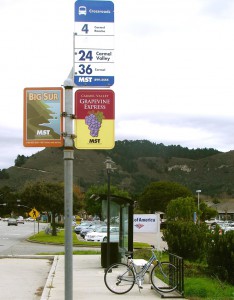
Remember: things that make biking safer include law enforcement. And you bet, if it’s necessary to give a citation for a BUI in Monterey County, local law enforcement is ready to take that action, as Marina Police showed in April 2016. Click here for the Californian’s report on the Marina Police Log.
Also for your consideration, see a 5/23/13 Sacramento Bee story by Sam McManis, “Bar-hopping cyclists risk tickets.”
19. Biking in the dark
Lights: When you’re Biking in the Dark, lights and reflectors are not only required by law, they are essential for safety when sharing a road with cars–and often for safety at other times too.
See the California DMV web page on “Equipment Requirements” for laws about night riding and other equipment: http://leginfo.legislature.ca.gov/faces/codes_displaySection.xhtml?lawCode=VEH§ionNum=21201. (For Spanish translation of equipment requirements for night riding and more–not available at the DMV website as of 3/22/13, refer to Bicycling Monterey’s en español page.)
Although a rear light is not required by CA law, it is recommended for safety. (Note: CA law requiring a rear reflector is anticipated to be changed to require that a bicycle operated at night be equipped with “a red reflector, a solid red light, or a flashing red light on the rear. ” Check CalBike.org for legislative updates, i.e., AB 28.)
Our local bike shops have plenty of lighting options, including those made by Light and Motion, a world-renowned local company that makes lightweight, high-powered lights.
Budget-minded lights: If your budget doesn’t allow the bike light you most desire, don’t be discouraged from night riding. See “Low-cost lights” in this site’s Biking in the Dark section.
Buddy system: In some locations, it makes sense to bike with a friend, or even in a group.
Changing your route: Changing your usual route is sometimes wise at night. For example, some people on bikes might skip the multi-use/bike path at night and instead bike in more traveled areas, even if it’s a road shared with cars–and infrequently, even a sidewalk. Overall, sidewalk riding is usually not recommended. However, do refer to the “Sidewalks” heading below for more discussion.)
Sidewalk riding at night: In addition to the sidewalk section below, check with local cities where you ride to be sure they don’t have an ordinance prohibiting sidewalk riding at night. For example, the City of Greenfield does, in their municipal code 10.28.040.
High-visibility apparel: As mentioned above, and even more so at night…
Better to be looked over than overlooked.
Monterey biker in a Graniterock vest; see “More Bicycle Safety Gear.”
20. Bicycles on sidewalks, and other local bicycle-related ordinances: Safety, teaching children, and local regulations/ordinances for Monterey County cities and unincorporated areas
California law leaves it to local jurisdictions to set rules for riding bikes on sidewalks. As CA VC Section 21650 states, “This section does not prohibit the operation of bicycles…on any sidewalk…where the operation is not otherwise prohibited by this code or local ordinance.”
Watch Bicycling Monterey’s 7-minute video and read the text about sidewalk riding:
In Spanish: ANDAR EN BICICLETA EN LAS ACERAS además de ejemplos de ordenanzas del Condado de Monterey, California – https://bikemonterey.org/andar-en-bicicleta-en-las-aceras-ademas-de-ejemplos-de-ordenanzas-del-condado-de-monterey-california.html
In English: BIKING ON SIDEWALKS, plus examples of ordinances from Monterey County, California – https://bikemonterey.org/biking-on-sidewalks-plus-examples-of-ordinances-from-monterey-county-california.html
Listen to Bicycling Monterey’s 90-second audio and read some additional info about sidewalk riding, and about crosswalks too: Bicycling on Sidewalks: Misconceptions and Advisories
Below, see “Local ordinances about bicycles on sidewalks, plus other local bike-related ordinances (for Monterey County communities).” Look for them just below a larger photo of this little boy.
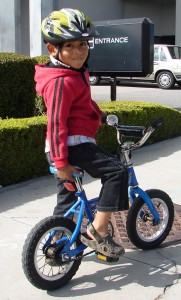
Get savvy about sidewalk riding–for safety, and to be a better ambassador for the bike community!
Please look over this entire sidewalk section. Feel free to contact me with any questions or comments.
Special thanks to the following for their research assistance regarding sidewalks: James Serrano, City of Salinas; Rich Deal, City of Monterey; Ariana Green, formerly with the City of Monterey; Christopher Kidd, board member of the California Bicycle Coalition; Jaime Rios, California Highway Patrol-Monterey branch and Start Smart instructor; Sgt. Michael Rice, Greenfield Police Department; and Undersheriff Michael R. Moore, Monterey County Sheriff’s Office.
Safety first
Coming off a sidewalk into a roadway (as pictured below) requires extra caution, as one Monterey County dad was sadly reminded.
In Monterey County, for the safety of all parties, you may generally assume that bicycling on sidewalks is discouraged–and in some cases, it is not permitted. Be sure to read “What about sidewalk riding for children?” below.
There may be signs posted that indicate “No bicycles” on sidewalks. Many signs are not at eye level, to reduce risk of vandalism. Look up higher, so you don’t miss the signs.
Example: Old Fisherman’s Wharf/Wharf I, City of Monterey had a sign at the entrance indicating no bike riding, since this wharf’s relatively narrow walkway is often heavily used by pedestrians. The sign was high up, to help prevent vandalism–unfortunately, this also makes it hard for most people to notice. (And the sign was sometimes tagged / wording covered by stickers.)
Will you get a ticket for riding on a sidewalk where prohibited? Use common sense. If you bike slowly and are considerate of others (e.g., yielding to pedestrians, and mindful of business entranceways), in most places in Monterey County, it is unlikely–although it is possible– that you will be ticketed for sidewalk riding. (Further down this section, a list of links to ordinances for some Monterey County cities, and unincorporated Monterey County, are provided.)
What if you feel safer on the sidewalk?
In most cases, riding on sidewalks is not safer than street-riding. Click here to learn why. (Update: A tough reminder was experienced by a Monterey County dad on 7/17/12. Click here for KSBW story. For related post on this site, click here.)
If you decide to use a sidewalk, check these “Top 5 Rules for Riding on a Sidewalk” from Commute by Bike.
Nonetheless, there are times when a person biking determines that a sidewalk is the safest place to bike. For example, rather than biking at night on a section of the bike path that is mostly deserted, or on an adjacent roadway with many cars, a person on a bike may decide that a sidewalk is their best option. One such example is the sidewalk parallel to Del Monte Avenue, alongside the Naval Postgraduate School fence; at night, many people (especially those biking alone) prefer this to the nearby bike path.
Another common area where less experienced bicyclists may feel safer on sidewalks is in East Salinas, such as on Sanborn Road, where traffic is typically heavy, and there are no bike lanes.
People in many other cities sometimes find a sidewalk is their best option too. For one example, click here for Michael Sullivan’s post about Southern California biking.
When biking where the road has no bike lane and has heavy vehicle traffic, and the road has a very long sidewalk parallel to it (with few breaks for driveways), that sidewalk may be the safest place to bike. Stay especially alert at driveways and intersections, and yield to pedestrians!
And please, if ever you’re biking on a sidewalk, s-l-o-w it down! Be a good ambassador for the bike community.
[6/4/16 update: Richard Masoner shared via his Cyclelicious blog post on 6/2/16, “What Pedestrians and Bicyclists Want Each Other to Know,” the work of Santa Cruz County Regional Transportation Commission’s Elderly and Disabled Transportation Advisory Committee. Please take time to read that helpful info, applicable everywhere.]
Before going into sidewalk riding ordinances for various Monterey County cities, let’s talk about sidewalks and children.
What about sidewalk riding for children?
Most people agree that children up to approximately age 13 (some say 9-13) cannot really make the necessary decisions about vehicle speed and distance that allow them to bike safely in the street.
For street riding, it is vital that a parent or other responsible adult bike with them and provide close supervision and guidance. But again, don’t be deceived by a false sense of security about sidewalk riding. Extra vigilance is required if they are practicing bike skills on a sidewalk! Teach children, and teens, those “Top 5 Rules for Riding on a Sidewalk” and other tips.
Another reason to help children practice bike skills on streets, accompanied by a supervising adult–and at the age and in the location where appropriate–is to help them move beyond the concept of the bicycle being a toy. Help children learn that a bicycle is a real form of transportation, with many benefits beyond fun.
And as with teaching teens to drive, give serious attention to their bicycling education–rules of the road, safe riding practices, courtesy to others, and more. Include teaching them about equipment maintenance (including taking advantage of local classes such as these).
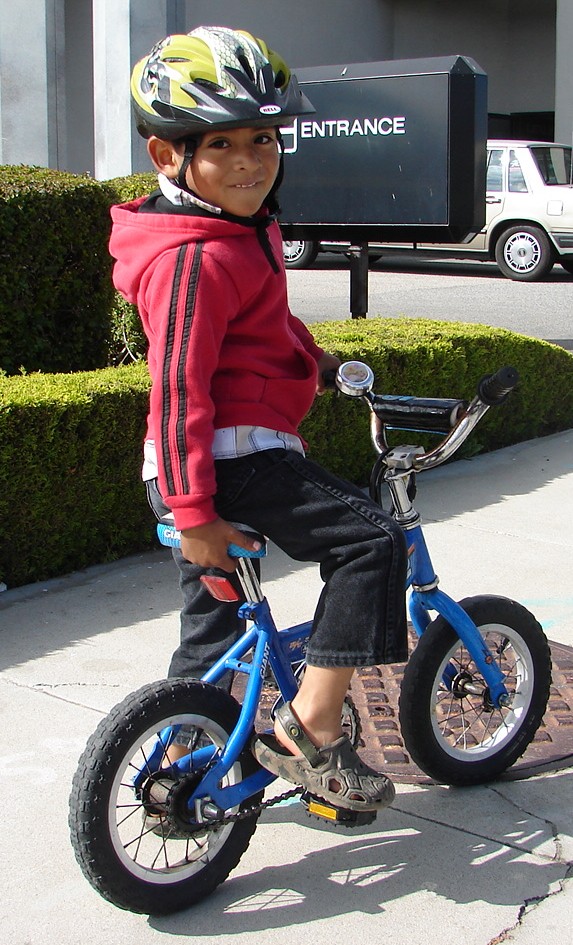 The Seaside boy above was biking on a sidewalk, accompanied by his mother. She was right alongside him, teaching him the importance of caution at all driveways, and intersections.
The Seaside boy above was biking on a sidewalk, accompanied by his mother. She was right alongside him, teaching him the importance of caution at all driveways, and intersections.
Local ordinances about bicycles on sidewalks, plus other local bike-related ordinances
Included below are municipal codes for the Monterey County cities of Carmel, Del Rey Oaks, Gonzales, Greenfield, King City, Marina, Monterey, Pacific Grove, Salinas, Sand City, Seaside, and Soledad, plus unincorporated Monterey County (which includes Carmel Valley, Castroville, Chualar, Pajaro, San Ardo, Spreckels, and more).
NOTE: Some local cities have additional bicycling regulations linked below. Are you unsure whether some of those additional regulations (other than the sidewalk regulations) differ from standard California bike laws? Some do, some don’t. Refer to the DMV codes linked at the bottom of this page, or contact local city police departments or city manager’s office (or for unincorporated Monterey County, contact sheriff’s office or your county supervisor’s office) to learn more about local regulations. Feel free to phone Bicycling Monterey with questions.
For any additions or changes to the information shared here, check with each local jurisdiction.
Sidewalk riding: City of Carmel
“It is unlawful for any person to ride, use or operate a bicycle upon any sidewalk within any of the commercial districts of the City. ” 10.40.010 (Ord. 79-21 § 29, 1979; Ord. 183 C.S. § 1, 1968; Code 1975 § 536.1).
Sidewalk riding: City of Del Rey Oaks
Municipal code (1995) 10.32.020 states, “No person shall ride a bicycle upon a sidewalk within a business district.”
Sidewalk riding: City of Gonzales
Municipal code states, “Operation On Sidewalks Prohibited: No person shall operate a bicycle upon a sidewalk within the city. ” (1972 Code § 10.52.130)
For additional Gonzales municipal code related to bicycling, click here.
Sidewalk riding: City of Greenfield
10.28.030 Riding on sidewalks in business district prohibited.
No person shall operate, or ride upon, or propel a skateboard or other human-powered device on a sidewalk in a business district in the city. For purposes of this section, the definition of “business district” set forth in Section 235 of the California Vehicle Code shall apply. (Ord. 314 §2 Exhibit A(part), 1986).
10.28.040 Riding after dark:
No person shall operate, or ride upon, or propel a skateboard or other human-powered device on any roadway or on any sidewalk in the city during hours of darkness; provided, that this section shall not apply to a properly equipped and licensed bicycle while the same is being operated on a roadway. (Ord. 314 §2 Exhibit A(part), 1986). [Note statewide update: California Assembly Bill 1909 (Friedman-Haney-Portantino), signed by the Governor on September 16, 2022, amends CA Vehicle Code Section 39002 so that a city or county that adopts a bicycle licensing ordinance or resolution shall not prohibit the operation of an unlicensed bicycle. See details, as well as when this and other bike-related provisions of AB 1909 become effective: https://leginfo.legislature.ca.gov/faces/billTextClient.xhtml?bill_id=202120220AB1909 ]
10.28.050 Violating Right Of Way:
No person shall operate, or ride, or propel a skateboard or other human powered device on any roadway or sidewalk in the city in such a manner as to violate the right of way of any vehicle or pedestrian, or as to endanger persons or property. (Ord. 314 §2 exhibit A, 1986)
For additional Greenfield municipal code related to bicycling, as of 8/10/16, see both sections 10.24 and 10.28 at http://www.codepublishing.com/CA/Greenfield/?Greenfield10/Greenfield1024.html&?f. Don’t overlook that section 10.28 on “skateboards and other human-powered devices” includes additional information for bicycles, as of 8/10/16.
Sidewalk riding: City of King City
Municipal code states, “It is unlawful to ride a bicycle upon any sidewalk.” 10.16.090
For additional King City ordinance related to bicycling, click here.
Sidewalk riding: City of Marina
Municipal code indicates that “In any area designated by resolution of the city council, it is unlawful to ride a bicycle…on any sidewalk….” 12.24.030 https://marina.municipal.codes/Code/12.24.030
For additional Marina municipal code related to bicycling, and skateboards, see https://marina.municipal.codes/Code/12.24
Sidewalk riding: City of Monterey
Bicycling on sidewalks in the City of Monterey is prohibited in certain areas (mostly downtown) where “signs are in place giving notice thereof,” per Section 22-12 (click here). Two places where you’ll see such signs, as of 7/17/15, are at the intersection of Alvarado and Polk (indicating no bike riding on sidewalks along Alvarado Street) and on Calle Principal at Jefferson, by Copy King (indicating no bike riding on sidewalks along Calle Principal).
The Alvarado Mall is the brick passageway, north of Del Monte Avenue, that runs between Custom House Plaza and Portola Plaza. About a decade ago, there were “No Bike” signs on the Alvarado Mall. The signs were removed by the City because Alvarado Mall is an important passageway between downtown and the waterfront for people who bike. The related ordinance is still on the books Section 20.-48.4 (click here) but will be updated in conjunction with the Monterey on the Move Plan. Just fyi, the “No Skate or Skateboard” signs remain due to the noise factor of skates and skateboards on the brick pavers.
See “Where the plazas are in the City of Monterey” for more about sidewalk riding on the city’s plazas, and on the Alvarado Mall.
For additional City of Monterey code on bicycling, refer to Section 22-12 click here.
As elsewhere in Monterey County, the City of Monterey generally encourages riding in the roadway, not on the sidewalk.
Sidewalk riding: City of Pacific Grove
Municipal code indicates, “No person shall ride a bicycle upon any sidewalk.”
For additional Pacific Grove regulations related to bicycling, see http://www.codepublishing.com/CA/pacificgrove/html/PacificGrove16/PacificGrove1632.html#16.32.080. Some ordinances may not yet be on PG’s official website. Refer to Bicycling Monterey’s post “Bike Pacific Grove” for some info about PG ordinances on e-bikes, pedicabs, and more. For updates, check with City of Pacific Grove.
Sidewalk riding: City of Salinas
In Salinas, city code reads, “No person shall ride a bicycle in any area designated as prohibited by resolution of the city council and where signs are in place giving notice of prohibition of bicycle riding.”
As confirmed 3/22/13, there is no prohibition on sidewalk riding except for a few areas of Oldtown/downtown. For children too young to bike on the street where sidewalk riding is prohibited–or anyone uncomfortable doing so– simply hop off and walk your bike on the sidewalk.
Even where sidewalk riding is not expressly prohibited, the City of Salinas encourages (adults) riding in roadways, not on sidewalks, in most cases for the safety of all concerned and for the reasons discussed above. And, of course, any time a person of any age determines that the sidewalk is where they feel safest riding, the City leaders urge vigilance about driveways, intersections, and such (those high-danger zones for people who choose to bike on sidewalks).
Remember that if biking on a sidewalk near pedestrians, business entrances, etc., bike very slowly. Always yield to pedestrians. In fact, Salinas code further states: “Any permitted bicycle riding on sidewalks shall be done with due caution and reasonable speed. The rider shall yield to all pedestrian traffic and shall give an audible signal before overtaking and passing such pedestrian.”
Click here to read Sec. 20-108. – (Ord. No. 2274 (NCS), § 6.)
For more about Salinas regulations regarding bicycling, click here.
Sidewalk riding: City of Sand City
There is nothing in the Sand City municipal code regarding bicycles, as of 8/12/16, as confirmed by the Sand City Police Department.
Nonetheless, it makes sense to practice in Sand City courtesies about sidewalk riding, such as: Use due caution and reasonable speed. Yield to all pedestrian traffic. Give an audible signal before overtaking and passing a pedestrian.
Sidewalk riding: City of Seaside
Municipal code indicates “No person shall ride a bicycle upon a sidewalk when doing so interferes with pedestrian traffic in any direction.” Ordinance 10.40.010.
Sidewalk riding: City of Soledad
Municipal code indicates “Bicycle licenses when issued shall entitle the licensee to operate a bicycle for which the license has been issued upon all the streets, alleys and public highways, exclusive of the sidewalks thereof, [emphasis mine] in the city.” Ordinance 10.08.040
[Note statewide update: California Assembly Bill 1909 (Friedman-Haney-Portantino), signed by the Governor on September 16, 2022, amends CA Vehicle Code Section 39002 so that a city or county that adopts a bicycle licensing ordinance or resolution shall not prohibit the operation of an unlicensed bicycle. See details, as well as when this and other bike-related provisions of AB 1909 become effective: https://leginfo.legislature.ca.gov/faces/billTextClient.xhtml?bill_id=202120220AB1909 ]
Sidewalk riding: Unincorporated areas of Monterey County
Unincorporated Monterey County includes Carmel Valley, Castroville, Chualar, Pajaro, San Ardo, Spreckels, and more.
Bicycling on sidewalks is allowed in unincorporated areas of Monterey County, because there is no part of the County of Monterey municipal codes that prohibits it.
Nonetheless, it makes sense to practice in unincorporated Monterey County courtesies about sidewalk riding, such as: Use due caution and reasonable speed. Yield to all pedestrian traffic. Give an audible signal before overtaking and passing a pedestrian.
What else to know: in the unincorporated areas of Monterey County, as of 8/12/16 (and as confirmed with the undersheriff on that date), people who bike are to simply follow the usual California bike laws, as outlined in the Vehicle Code (and discussed elsewhere on this web page).
There’s one exception: what is in the County of Monterey municipal codes about bicycling pertains specifically to county parks. See items 28-30 under “14.12.130 – Miscellaneous prohibited acts.” Refer to the county website for any possible updates, but because the bicycle information is fairly difficult to find there, that information is quoted here, as it appeared under code 14.12.130 on 8/12/16. In Monterey County parks, it is prohibited to: “28. Ride, use, or be in possession of a bicycle on any trail not authorized for such use by the Parks Department. 29. Ride, use, or be in possession of a bicycle without having positive identification in his or her possession. 30. Ride a bicycle on any authorized dirt trail without wearing a protective helmet [even if you’re over age 18] that is certified by ANSI, SNELL, or both. 31. Ride a bicycle or horse in willful or wanton disregard for the safety of persons or property.”
More about sidewalk riding, for all of CA
As stated above, CA law leaves it to local jurisdictions to set rules for bicycling on sidewalks. As CA VC Section 21650 states, “This section does not prohibit the operation of bicycles…on any sidewalk…where the operation is not otherwise prohibited by this code or local ordinance [such as, those cited above].”
As of 11/20/12, Christopher Kidd, board member of the California Bicycle Coalition–had compiled a helpful list of 535 local jurisdictions (cities, counties) in California and their sidewalk cycling rules. (Thanks to Richard Masoner of Cyclelicious for highlighting Kidd’s research in the Cyclelicious 11/16/12 sidewalk riding post.) Kidd’s research covers a lot of ground. Per standard recommendations, you may wish to confirm specifics on local areas with local traffic engineers, transportation agencies, bicycle alliances/coalitions, or other local sources. See Kidd’s notes on the sidewalk riding spreadsheet to avoid confusion, e.g., about “Allowed everywhere.” His sidewalk riding rules document gives more specific guidelines. Special thanks to Christopher Kidd for sharing his sidewalk cycling research.
Just a bit more about sidewalk use: street etiquette for Ciclovía Salinas dates includes sidewalk courtesies as well.
- English: Ciclovia Salinas Etiquette (v6)
- español: Ciclovía Salinas – Reglas de comportamiento y la Ley (v2).
“Did you say Ciclovia Salinas? That’s one of the coolest events in our hometown!”
Below, Monterey County residents the Warwick sisters, preparing to bike Salinas to Solvang with their dad.
* * *
The Bicycling Monterey site and projects are provided as a public service. Volunteers and contributions are welcome and appreciated.
* * *
21. Children, teens, and family cycling
Teens: Out cruising with your buddies and want to be sure there’s no cause for a ticket–but don’t have time to review all the bike laws? Check Bike law summary – bilingual. And click here for examples of how Monterey County law enforcement is supporting people who bike!
Stop at red lights and stop signs? Yes.
Use your browser’s “find” feature to quickly locate all references to “children” on this Bicycling Monterey web page. Below are some additional tips for kids–from babies to teenagers.
It makes sense that sometimes children and teens—and adults too—don’t bike because they’re concerned about being bothered by dogs or people. See sections 29 and 30 below for tips about dogs and tips about street harassment and other bullying.
Among bike advocacy organizations whose resources we appreciate—including because of their resources in multiple languages— is Cycle Toronto. No matter where you live, you’ll find some helpful info in their resources including—new in 2019—their Toronto Cyclists Handbook: Family Edition. https://www.cycleto.ca/handbook
First, is your baby or child at the recommended age to begin?
Most reliable resources urge that infants under the age of one should not be transported on a bicycle. At minimum, sources recommend that a baby be able to hold their head up steadily and fit a helmet. In addition, whether baby rides in a mounted seat or in a bike trailer, it is recommended to use a three- or five-point harness seatbelt at all times.
- The Pedestrian and Bicycle Information Center (bicyclinginfo.org) in age-specific recommendations for ages 1-5 states: “Children under the age of one should never be transported on a bicycle. Until a child is able to hold up his or her head independently, do not allow her or him to ride as a passenger.”
- The League of American Bicyclists tips on kids and bikes states, “Once a child can hold their head up and fit a helmet, they can be a passenger.”
Also see the age-specific recommendations linked below.
Passengers on a bicycle: CA legal requirements
It is not okay to carry a child in the types of child carriers–such as backpacks–appropriate for transporting a child while walking. In California, bicycle passengers weighing 40 pounds or less must have a seat that keeps them in place and protects them from moving parts. California law has very specific requirements about carrying passengers, and among requirements about bike passengers of all ages, specifically states: ” If the passenger is four years of age or younger, or weighs 40 pounds or less, the seat shall have adequate provision for retaining the passenger in place and for protecting the passenger from the moving parts of the bicycle.” (CA Vehicle Code section 21204.)
The little one below, who is over one year old–and able to hold her head up steadily–is a terrific age to begin a love affair with bicycling. Note that her dad tipped her helmet back, so her face could be seen for this photo. Helmets should normally cover the forehead.
If your child is ready, note carefully:
- Children younger than approximately age thirteen (some say age nine to thirteen) cannot really make the necessary decisions about vehicle speed and distance that allow them to bike safely in the street. However, sidewalk riding absolutely has its dangers! See “sidewalk” tips on this web page. Parental guidance is important, even on most sidewalks.
- So children under 9-13 should never bike in a street? It’s not recommended in most case if the children are on their own.
- To give them street biking experience, at the age and on appropriate routes, refer to the resources below regarding age-specific recommendations and tips for teaching kids to ride safely.
- Adults must choose appropriate streets on which children can learn. (How to choose appropriate routes? Choose appropriate Monterey County routes for children by making use of “Where to Bike in Monterey County” and the Bicycle Maps section. Feel free to phone Bicycling Monterey for ideas, or with questions.
- Stay right alongside the children, either by bike or on foot, and providing close supervision. Riding as “wingman,” to the left and just slightly behind your child, is most often the safest scenario.
- In advance, be sure you are knowledgeable about bike laws and safe riding practices (review the information, videos, and resource links found on this web page). Be a consistent role model for your child, such as in using hand signals, looking carefully at driveways, etc.
- Also ahead of time, try out the route on your own, without the children, to spot any potential problem areas.
- When children become older, they’ll be tempted to take risks. Their peers may tease them about hand signaling, wearing a helmet (required by law for under 18 in CA), or other bike laws or safety practices you have taught them. Even though they ride alone with peers now, don’t give up your own rides with your teens. Keep those up too! Use your rides together as opportunities to reinforce their “biker’s ed,” and to point out examples of why the guidelines you’ve taught them matter to keeping them safe.
Age-specific recommendations
and more resources for biking with children
- Ideas for Teaching Cycling to Children is a good resource. It was written by Fred Oswald, a League of American Bicyclists certified instructor.
- Our Monterey Bay neighbors at Ecology Action in Santa Cruz have a detailed web section on Bicycle Safety Tips for Youth.
- [Note well the info above about “Is your child ready?”] I Am Traffic offers “Cycling with Children,” which suggests that “Children between the ages of 7 and 10 can develop the traffic and handling skills to operate safely on low speed, low traffic two-lane residential streets. By their early teens, they can develop the skills to handle multiple lane streets.”
- Age-specific recommendations (for ages 1-5, 5-8, 9-12, 13-17–also found in the right-hand panel of the “Educating Children and Teens” section) are provided by the Pedestrian and Bicycle Information Center (bicyclinginfo.org).
- You may also glean useful info from Kids and Bike Safety at http://www.nhtsa.gov/people/injury/pedbimot/bike/KidsandBikeSafetyWeb/index.htm and from the International Bicycle Fund’s Teaching/Learning to Bike and Teaching Children Bicycle Safety.
- The Monterey Public Library has a DVD most kids will find is a fun way to get an overview about bike safety: “Bike Safety with Bill Nye the Science Guy,” which also includes a bit of info on skateboard and roller skate safety too. Ask for it at your local library.
- Have a child old enough to want to listen to music while biking–or to text or talk on a cell phone? Review together the “Cell phones and texting” and “Keep one ear unplugged” info on this web page. If they watch “Bike Safety with Bill Nye the Science Guy,” they’ll hear Bill refer to not using headphones while biking. Teens will be glad to know that one ear bud is permitted by CA law, just not both ears. Still, keeping the volume adequately down to prevent distraction is important too.
- If you have children or teens interested in mountain biking, take advantage of the Monterey Off Road Cycling Association / MORCA’s Take a Kid Mountain Biking Day, where they’ll receive safety instruction while having fun. (MORCA has regularly scheduled rides for a variety of abilities and is happy to help adults learn mountain biking safety as well. Their activities are included on Bicycling Monterey’s master calendar, or to focus on MORCA activities only, refer to the MORCA calendar at MORCAmtb.org.
- Some families have gained a lot of experience by bicycle touring with children. Visit the Harrison Family AKA Pedouins, who visited Monterey County and authored A Pedouin Life: Stop and Smell the Artichokes. Another is The Family on Bikes website, which includes Tips on Bicycling with Children.
- The American Academy of Pediatricians offers these myths and facts about children biking.
- Companies that manufacture bikes and bike-related items for use with children typically address some safety questions on their sites (e.g., Burley “Child Trailers” FAQs.)
- As mentioned earlier regarding cargo carrying, Carfree with Kids offers “Handouts summarizing gear options for biking with small children,” which includes a chart summarizing kid-hauling bike accessories and cargo bikes.
- New options for biking with young ones are coming out all the time. Do your research before purchasing, and if available, consider renting or trying a demo before purchase. One that was brought to my attention in April 2016 is this one: http://www.tagabikes.com/history.asp When purchasing, consider the manufacturing practices too, e.g., where was the bike made. Whenever possible, purchase from a local bike shop.
- Training wheels have fallen out of favor with many people. But what about “balance bikes”—is it necessary to buy a special bike such as that so your child can first learn to ride by gliding? Many people say no; instead, they simply take the pedals off a regular bicycle and lower the saddle so the young rider can sit on it with their feet on the ground. From there, the child can push off with their own two feet and glide along on the bike. After they’ve learned to safely balance, the bicycle’s pedals can be put back on, the saddle moved up, and they can now be taught how to pedal.
Looking for Safe Routes to School-type info? Click here.
- Want some inspiration from Monterey County elementary school educators–and the children they bike with? These educators, who are well experienced cyclists, are teaching children bike safety not just in the classroom and on the playground, but out in the community too! That’s right, hands-on (the-handlebars) instruction to help teach children how to safely navigate their community by bike. Click here for a story about Monterey Park Cycling, Salinas.
- Here’s more inspiration, in the realm of “Bicycle Advocacy: What you can do“: Our Monterey Bay region neighbors in San Benito County even provide, in English and Spanish, Safe Routes to Schools brochures featuring maps of suggested bicycling and walking routes to each individual school!
- See”Bicycling Children Growing Up Street-Wise” for inspiration from Monterey County parents and teachers.
- Want more photo inspiration? You’ll find it in the children and teens section of this site. For additional photos, see “Babes on Bikes” and “Babes on Bikes II” (the latter includes Monterey County children) by Anna Fahey in Sightline Daily: News & Views for a Sustainable Northwest.
Also see other posts in the “Children and Teens” category of this website, including “Bicycle culture and youth,” which has a few tips about kids and helmets–and sources for some extra cool ones.
Equipment for use with infants and younger children
- The League of American Bicyclists has recommended that bike trailers are safer than mounted seats, and that a ball and socket joint where the bike and trailer meet prevents the trailer from tipping over if the bike does.
- Personally, my son (older child) rode in a mounted seat. His sister (younger child) rode in a trailer. A parent asked me recently how I liked the Burley trailer I used with my daughter. I liked it a lot! There are also many new options available to parents today. One example: The Winther Kangaroo, with U.S. dealers available.
- Another option for biking with kids, especially when you want to venture out on roads with kids who are just learning to be street-wise, is a trail-a-bike. If you want to try one out before purchasing, rent one from a local shop.
- Bike trailers and kids’ bikes are low to the ground. High-visibility flags make sense! Take a look at the fashionable flags from Purple Sky/Catrike Flags and the high-visibility flags from Be Seen Wear. For more about flags, see “High-Visibility: Dress for Success.”
- Also see Bicycling Monterey’s section on “High-visibility apparel and accessories.”
Trail-a-bikes are increasingly popular–and rightly so.
22. Stay legal on the street
When you’re riding on a road (shared with cars), keep those aforementioned California bike laws in mind. Below are some examples.
And beyond biking legally, please remember to bike polite! What does that mean?
The word “etiquette” appears in multiple sections of this webpage, and around the Bicycling Monterey website. Variations of “bike polite” are part of the party rules when Rob Garcia hosted Salinas Bike Party rides; part of Ciclovia Salinas etiquette; and part of Monterey Off Road Cycling Association’s passing etiquette, all referenced on this webpage under “Group ride etiquette.” Biking polite is also referred to in our outreach such as “Bicycling on sidewalks: misconceptions and advisories” in the Californian.
Whether you’re on a street, sidewalk, trail, or elsewhere, please be a good ambassador for bicycling by biking polite. As that relates to street riding, also see I Am Traffic’s “What is a courteous cyclist” by Steven Goodridge.
Okay, what about staying legal on the street?
Single file or side-by-side?
Is it okay to ride alongside another person on a bike, or must you ride single file? Basically, whenever you are riding slow enough to impede traffic, ride single file. See our neighboring county’s Street Smart Santa Cruz post “Cycling Side by Side” for a detailed answer that cites California law. For further applicable comments, from bikeportland.org, see “Bike Law 101: Riding Two Abreast.”
Required equipment
Other legal requirements have to do with necessary equipment, including bike helmets for children/teens under age eighteen, and seat, reflectors, light, brake, and such for all ages.
Yes, on California roadways, “bicycles must be equipped with a brake that allows an operator to execute a one-braked-wheel skid on dry, level, clean pavement,” per CVC 21201(a).
Heads-up for fixie riders: If you view this video (click here) about ways to stop a fixed-gear bike, note that their #1 recommendation is to have a front brake! (In the absence of that, also note that their “ways to stop” all require clips or straps.) Thanks to Salinas Bike Party, a courteous social bike run, for this video link.
Proper lane usage
In Monterey County, the bicycle community and leading law enforcement professionals want to avoid incidents such as this (in San Diego), where a cyclist was incorrectly ticketed although they had followed California law about lane usage for bicyclists (click here, and scroll down too). San Diego responded with trainings for police officers on cyclists’ rights and laws, and its police department also issued a helpful memo to its officers on bicycle traffic enforcement.
In Monterey County, we’re fortunate. Our local police departments are pretty bike-savvy! Check out these Constables of the Peace in Monterey County; they aren’t just bike-friendly, they are biking themselves.
If ever you feel you’ve been incorrectly warned–or even mistakenly ticketed…
Please notify the head of the law enforcement agency that ticketed you, such as a local city police department, Monterey County Sheriff’s Office, or California Highway Patrol-Monterey branch office.
Feel free to phone Bicycling Monterey with any questions about CA bike laws and Monterey County ordinances.
If you do get a ticket while bicycling…
Since September 2015, California law, AB 902, makes it possible–for certain infractions–to attend a class on safe bicycle riding and thus reduce your fine. The Transportation Agency for Monterey County sometimes offers classes that may meet this requirement; contact TAMC’s bike-ped coordinator to inquire.
Our Monterey Bay region neighbors in Santa Cruz County had a “Bike Traffic School” program in place even before AB 902 was signed into law. Check it out here.
Tip for law enforcement professionals
Monterey County police departments can request complimentary trainings about bike laws. Phone Bicycling Monterey if you are a new officer in Monterey County, or even if you are not new, and you or your fellow officers would like such a training as a refresher.
23. Avoiding the door zone
Watch this three-minute video on YouTube, “Why you should avoid the door zone.” See “Distracted? Watch out! We’re all family” for another video that brings the point home.
Wondering about cars parked in bike lanes? It is legal to park in a bicycle lane if the vehicle does not block bicyclists and/or if there is not a “No Parking/Bike Lane” sign posted. We are fortunate in Monterey County to have many “No Parking/Bike Lane” signs; see Signs of a Bicycling Friendly Monterey County.
And whenever you’re a driver or passenger in a motor vehicle, please get in the habit of using the Dutch Reach. http://www.dutchreach.org
24. What about freeways and bridges?
You are free to ride a bicycle on all streets and even highways, unless otherwise posted (as provided in CA VC 21960). Note:
- Freeways or expressways are an exception; you may not ride on most of these! Signs tell when a person on a bike must not enter. Please watch for these signs–and if in doubt, use an alternate route.
- A second exception is some bridges; watch for signs indicating no bicycles.
25. Emergency contact info; also, first aid tips for smartphone users
When you’re biking—as anytime—it makes sense to have emergency contact info handy, just in case a need for it arises. Some people keep such info in a cell phone, or on paper in a pouch or pocket. Others find it convenient to wear that info, e.g., in their shoe, or around their wrist or neck, engraved on a “road identification” tag like the one pictured below. (Personal emergency contact info is on reverse side; the company making that tag, Road ID https://www.roadid.com, offers options such as the music theme pictured for the alternate side.)
Consider putting Red Cross first aid tips in your phone. They can be downloaded from: https://www.redcross.org/get-help/how-to-prepare-for-emergencies/mobile-apps.html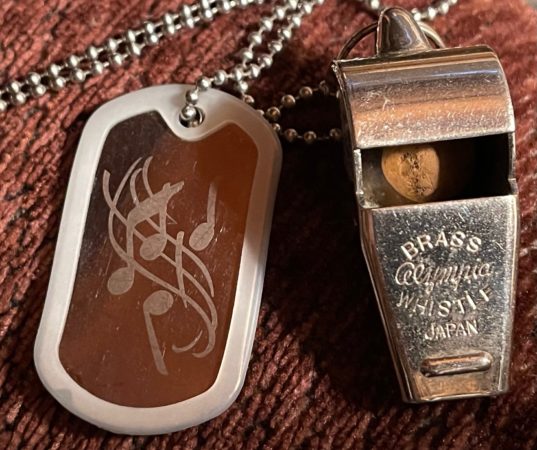
26. Taking responsibility for personal safety
Bicycling Monterey encourages being mindful about personal safety. That doesn’t mean always wearing high-visibility apparel, instead of a preferred fashion. (Of course, there’s also the option to add a reflective sash or other high-visibility item to your outfit. See this guide’s section on More Bike Safety Gear.)
It also makes sense that many people on bikes prefer feeling the wind in their hair over wearing a helmet.
Yes, bike safety isn’t ensured by a neon jacket, or a helmet, anyway. There’s indeed a need for safer bikeways in nearly every state and country! (See local, state, and national infrastructure resources below.)
Mutual respect and cooperation are reasonable expectations to have on shared routes, though unfortunately not found 100% of the time. That’s true of roads shared by bicycles and cars, and it’s also true of the multi-use path, which is intended for use by joggers, skaters, and pedestrians too.
Advisory for skateboarders: Section 22-14 of the Monterey City Code states “No person shall ride or propel a skateboard on the Recreation Trail between the head of Municipal Wharf No. 1 and the City limit with Pacific Grove.” For any updates, check with City of Monterey.
The young military service personnel below are out having fun on the bike/multi-use path, too. They cheerfully share the path with others, with a mindfulness about safety for everyone.
Skateboarders will want to stay alert for signs. For example, skateboarding is allowed on the City of Monterey’s section of the coastal trail where this couple was photographed, near the Naval Postgraduate School. However, skateboarding is not permitted in between Wharf I and Pacific Grove.
For a little about skateboarding on this site, see “Bicycle Parking, Security, and Storage.”
Just as with people who drive cars on a regular basis, nearly every person who frequently rides a bike has at least one story of a frustrating—if not injurious or life-threatening—experience while traveling around others.
- Perhaps it’s a pedestrian on a cell phone wandering into the bikeway, oblivious to the person on a bike who has to slam on their bike brake/s to avoid hitting him or her.
- Or it may be an experience of being “doored” by a driver exiting a vehicle without looking to see that there’s a bicycle coming alongside.
- It may be another person on a bike who puts you at risk, even from something as unintentional as losing their balance and crossing into your lane.
Likewise there are pedestrians or drivers who have stories about distracted or arrogant people on bikes. And since so few people on bikes live a car-free life, most of us have shared-road tales from all perspectives.
The point is, both better bicycle infrastructure and a heightened awareness about and respect for sharing the various types of bikeways in a community make a difference in bike safety.
And the more people who bicycle in a community, the safer it is to cycle there. That’s what Bicycling Monterey is all about: encouraging more bicycling in Monterey County, along with encouraging a more positive share-the-road, share-the-multi-use-path, share-the-beauty way of thinking and being.
Below, Al Abbott of Abbott Plumbing, Salinas
enjoying a Sunday afternoon on the multiuse trail,
using a cross-training street strider.
27. What about e-bikes /eBikes and other non people-powered bikes?
E-Bike Safety and Training Programs: https://bikemonterey.org/e-bike-safety-and-training.html.
See too Los Angeles Times staff writer Karen Garcia’s 8/16/22 article “E-bikes aren’t just faster, they’re a different ride. Here are safety tips.” https://www.latimes.com/california/story/2022-08-16/e-bike-safety-not-just-faster-theyre-a-different-ride
As mentioned in the helmet section of this page, e-bike riders may wish to consider: https://helmets.org/ebike.htm.
California law (still in flux re: e-bikes) has stated “Must be 16 years of age or older to ride a Class 3 electric bicycle.” For details on CA law and any updates to laws, and the classes of e-bikes, see https://www.chp.ca.gov/programs-services/programs/california-motorcyclist-safety/motorcycles-and-similar-vehicles.
Also refer to Bicycling Monterey’s post “Regulations for E-Bikes / Electric-Assist Bicycles and Other Non People-Powered Bikes — in Monterey County and Elsewhere.” As noted there, on July 14, 2025 AB 544 was signed by the Governor. Provisions of the bill include requiring an electric bicycle during all hours to be equipped with a red reflector or a solid or flashing red light with a built-in reflector on the rear that is visible from a distance of 500 feet to the rear. https://leginfo.legislature.ca.gov/faces/billNavClient.xhtml?bill_id=202520260AB544
28. Local, state, and national resources: Help improve infrastructure for safer bicycling
On the local level, here in Monterey County, see “Bicycle advocacy: What you can do.” Also refer to Monterey County Bicycling Resources / Bike Community Leaders.
Statewide and on the national level, contact state and federal legislators regarding bike-related legislation. Support the work of state and national bike advocacy groups, such as the following. They work to address issues ranging from Protected Bike Lanes to bike infrastructure around train tracks / railroad tracks—see a related City Lab report, http://www.citylab.com/transportation/2017/08/the-brutal-saga-of-one-very-poorly-designed-railroad-crossing/535926/
- California Bicycle Coalition (Also see Bike Safe California /bikesafecalifornia.org, a project of the California Bicycle Coalition, which offers bike safety resources.)
- People for Bikes: Check out their cool videos and sign the pledge.
- Alliance for Biking and Walking: Make use of their resources, including webinars like their 9-14-11 one on outreach to Spanish-speaking communities. (Click here for Bicycling Monterey’s compilation of Spanish biking resources.)
- Safe Routes to School: Check out what’s happening locally, and respond to requests for SRTS support. Take advantage of SRTS webinars, like their 2011 one on bike parking/security/storage. (Click here for Bicycling Monterey’s bicycle parking, security, and storage post.
Then scroll down it for notes from that webinar.) - League of American Bicyclists: Make use of help offered by local League instructors.
- Among national resources, U.S. Department of Transportation, Federal Highway Administration: http://safety.fhwa.dot.gov/ped_bike/, including a Feb 2019 report “Bikeway Selection Guide” http://safety.fhwa.dot.gov/ped_bike/tools_solve/docs/fhwasa18077.pdf
Railroad track / train track caution sign in our neighboring Santa Cruz County
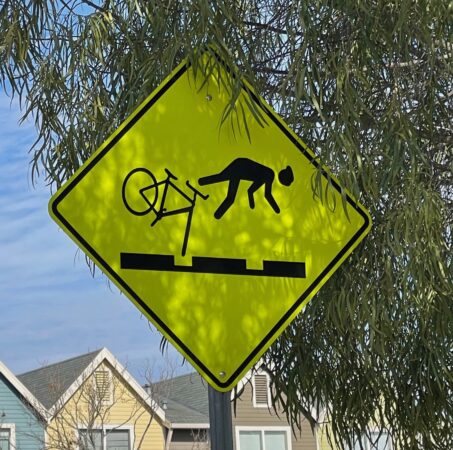
29. Biking with a Dog
Refer to “Tips for dog-lovers biking Monterey County, and elsewhere.”
30. Street Harassment and Other Bullying
Refer to Bicycling Monterey’s post “Street Harassment and Other Bullying: Ways to help stop it – resources in Spanish and English.”
31. Eye Protection
Don’t care about protecting your eyes from sun, dust, wind, and the like? How about bugs? Anyone who has biked without sunglasses or other eye protection has probably had an insect in their eye at some point!
Wrap-around sunglasses are usually recommended for bicycling. A web search will turn up all sorts of product reviews and brand recommendations; we’ll leave that research and purchase decisions to you. Higher prices typically mean choice of lens tints and even extra lenses for varying conditions, and top-end optic quality. Lightweight frames and adjustable fit are additional benefits of most high-end glasses.
32. Special considerations: skirt guards
Skirt guards are a helpful accessory for people who bike in skirts, dresses, or other long, flowing apparel. We spotted the woman above biking with several companions who were also in skirts. We noticed their skirts flying in the breeze, and we thought: They’re having such fun! And they sure could benefit from skirt guards. Soon after, we saw the same riders, stopped along the roadside. As the photo above shows, a skirt can get tangled! The result may only be that the clothing gets greasy or torn, and biking is at least temporarily halted. But the result can be even worse: an injury to the person biking or to others nearby.
Not only are skirt guards sold, many people make their own. You may find one of the following resources helpful: a Howcast YouTube http://youtu.be/1NIpGrgPa7s or an instructionables.com post on “how to make a skirt guard.”
33. Special considerations, for e-bikes and traditional bicycles: speed wobble
For common causes, see Jim Langley’s article “Things to Know About Speed Wobble”: https://www.roadbikerider.com/avoiding-bicycle-speed-wobble/
34. Links to DMV Vehicle Code – Bicycles
For ease of referral, below is an excerpt from the California DMV website, courtesy of the California Department of Motor Vehicles.
The California Vehicle Code is no longer available on the DMV website. Site visitors are now referred to California Legislative Information to view the California Vehicle Code. Volunteer to help fix the many broken links that have resulted from this change.
Thanks to California Bicycle Coalition for their helpfulness resulting from their 2016 website redesign. You can access the most relevant California Vehicle Codes (in their new location) on Cal Bike’s “California Bike Laws” page; click here.
(Spanish speakers: Lo siento. As of 22 March 2013, these DMV links lead to a “Disponible sólo en inglés” message. Update: As of May 6, 2017, CA DMV now uses Google translate; click here for DMV’s Bicycle Resources page, then access their translate button at lower right.)
BICYCLES
Generally, 21200–21210, 39000–39009, 39011
Carrying of articles, 21205
Change of address, 39009
Dealer defined, 39006
Defined, 231, 21200, 39000
Direction ridden, 21650.1
Equipment, 21201
Fees, 39001, 39004
Fines, 39011
Freeway, use on, 21960
Helmets, 21212
Hitching rides, 21203
Indicia, 39001, 39003
Lanes, see BICYCLE LANES
License
Department of Motor Vehicles, 39001
fee, 39001, 39004
form, 39001
local authority, 39003
original, 39004
renewal, 39001, 39004
replacement, 39004
transfer, 39004
Local authority, 21100, 21206, 39002
Motorized
defined, 406
driver’s license required, 12509
registration exemption, 4020
use of bike lanes, 21209
Mutilation of license or serial number, 39002
Notice to correct, 40303.5
One–way streets, 21202
Operating without license, 39002
Parking, 21210
Passengers, 21204
Path, see BICYCLE PATH
Pedicabs
definition, 467.5
Records
content, 39005
supplied by retailer, 39006
Reflectorized equipment, 21201–21201.5
Registration forms, 39001
Rules of the road, 21200, 21202
Seat, 21204
Serial number, 39007
Signals, 21456.3
Toll facilities, 23330
Towing, 21203, 21712
Traffic signals, 21456.2
Transfer of registration, 39008
Transported on Buses, 35400 , 35400.9
Local regulation, 21207
Motorized bicycles, 21207.5
Motorized scooters, 21229
Obstruction of, 21211
Pedestrians, 21966
Turning across, 21717
Use of, 21208–21209
Levees, 21116
Motorized scooters 21230
Motorized skateboards, 21968
Path crossing definition, 231.6
Path definition, 231.5
Pipeline right–of–way, 21116
Unauthorized vehicles, 23127
Find info of value on this site? Contributions are appreciated. Click here.
Special thanks to Frank Henderson for serving as a bike safety advisor, and Cath Tendler-Valencia for supporting the work of “bike laws and safety tips”outreach in Monterey County and beyond.
Short link to this page: http://bit.ly/SkillsSafetyLaws
(In Bicycling Monterey’s 11th year, the old short links to this page—http://bit.ly/LawsSkillsSafety or http://bit.ly/CABikeLaws—are being retired.)

